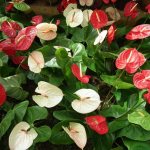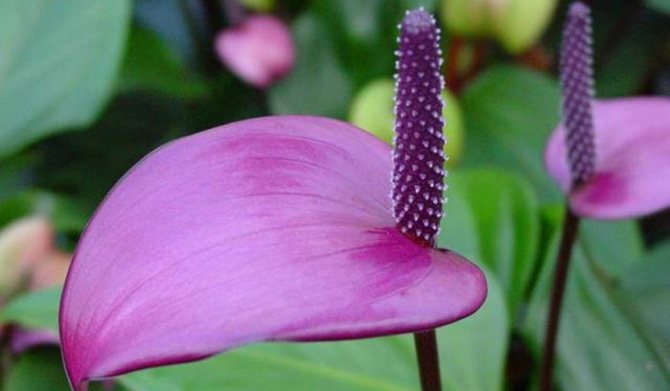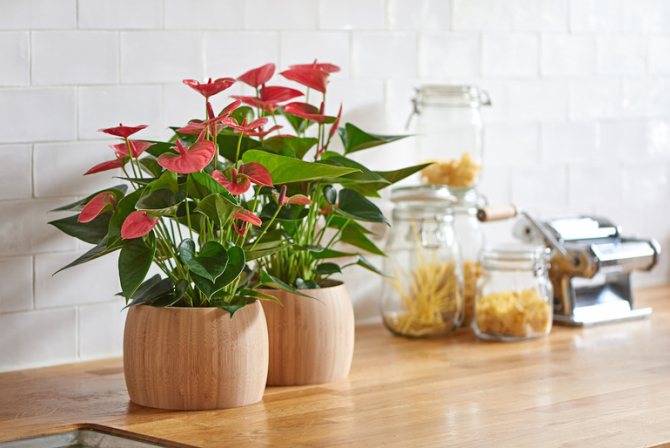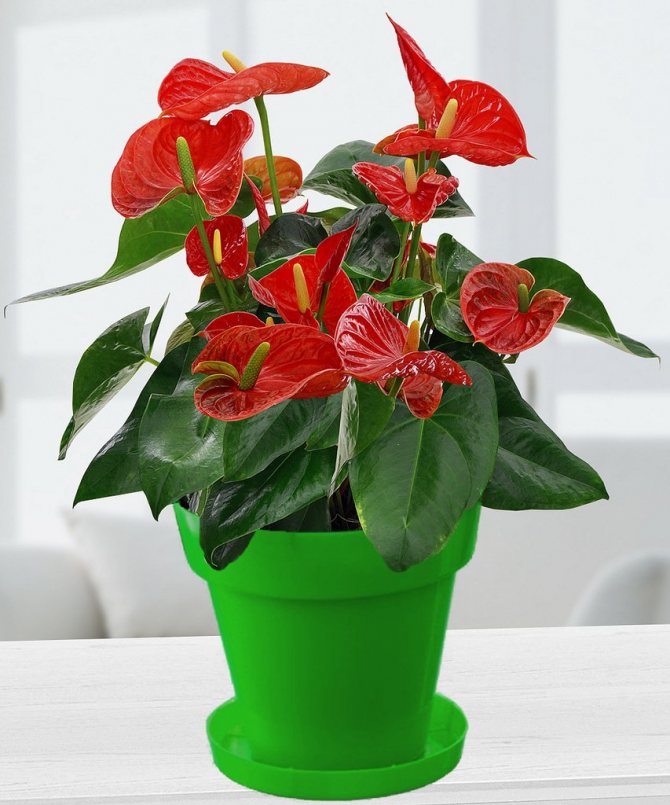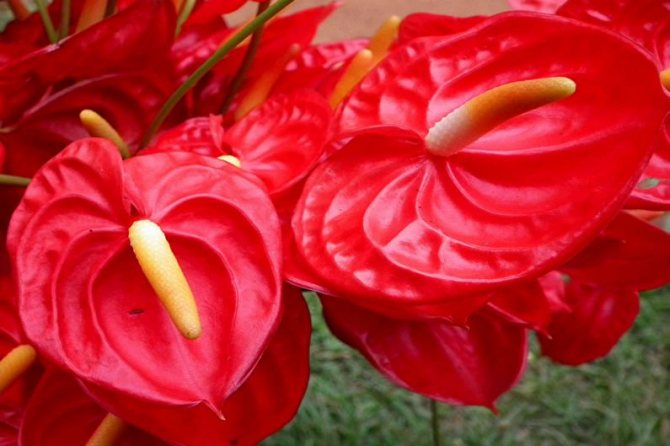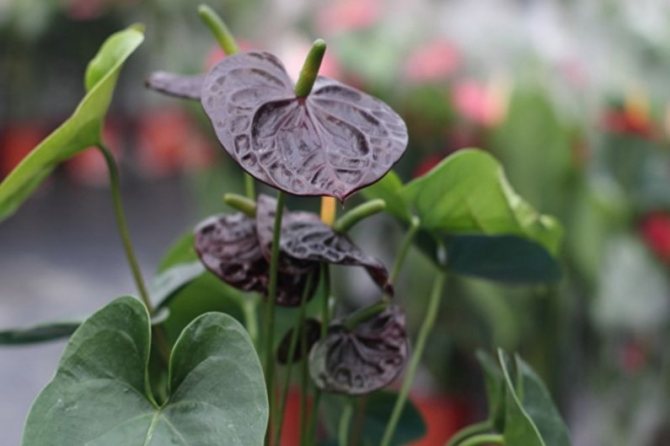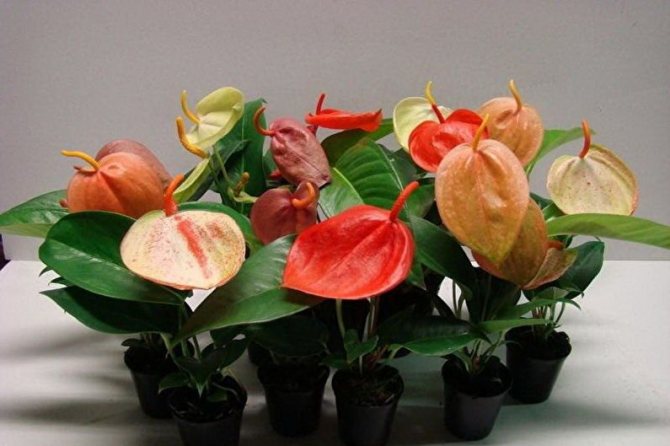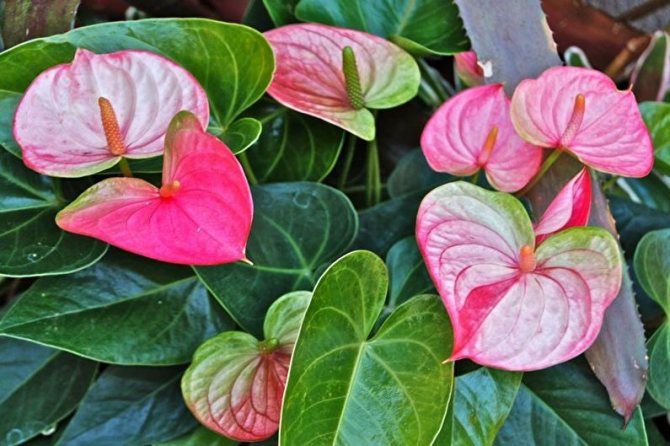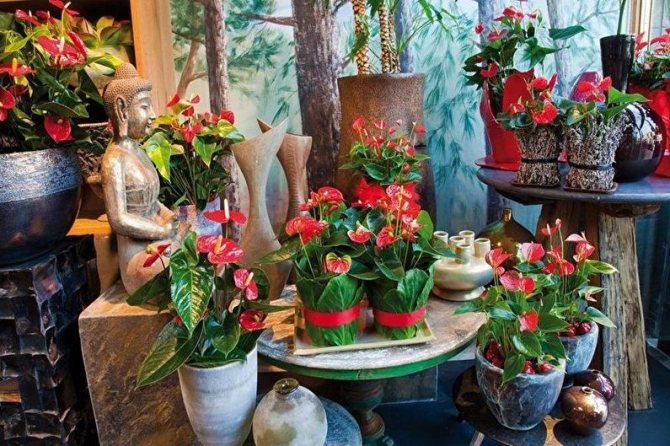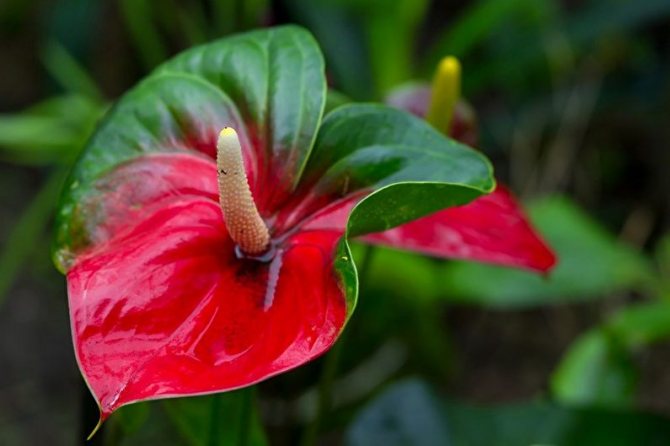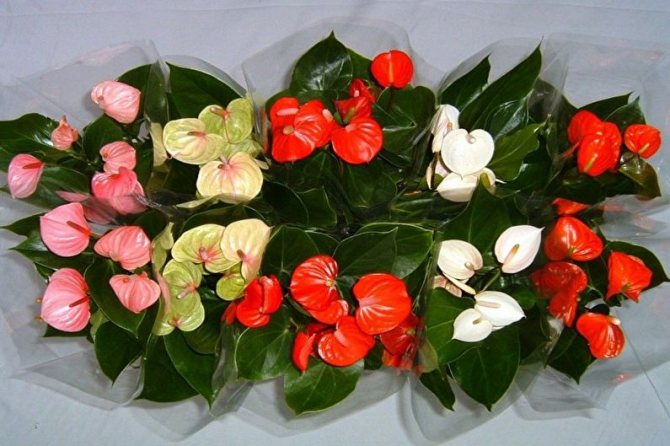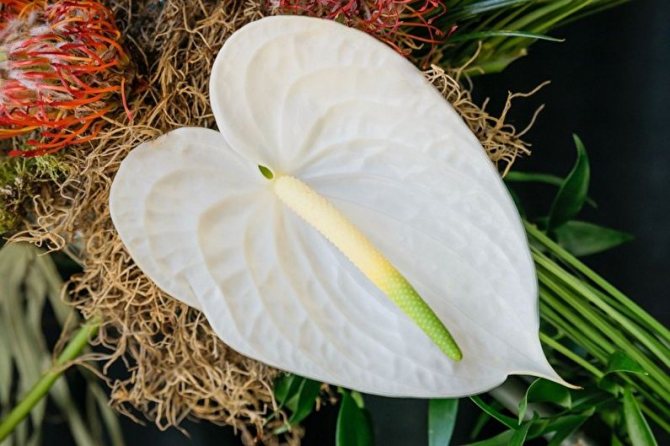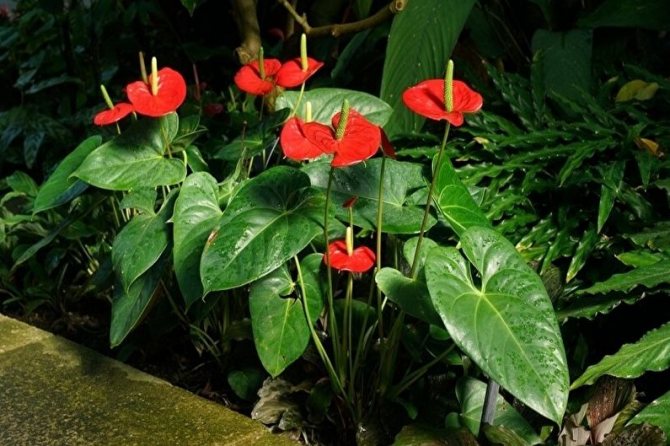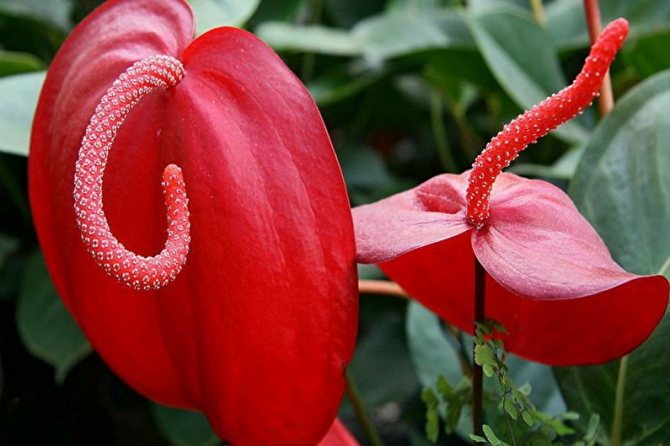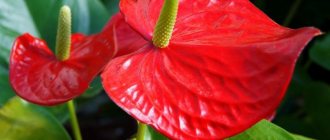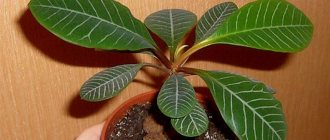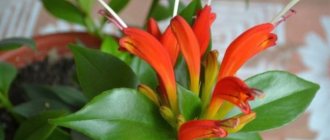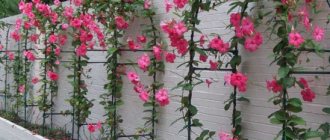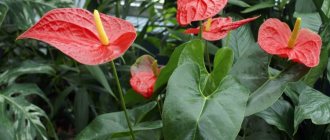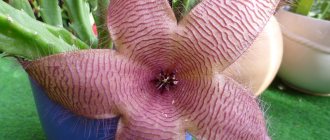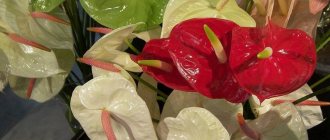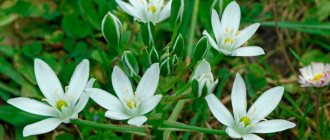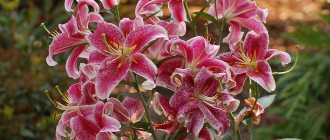Anthurium is a very beautiful, amazing flower, the homeland of which is considered to be South and Central America. It is a houseplant from the Aroid family. This flower is popular not only for its amazing appearance, unique flower shape.
Dear Readers! For you, we have created communities in social networks, in which useful articles and interesting ideas are published several times a day! Subscribe and receive useful content in a convenient format!
It is believed that it is able to bring good luck to its owners, attract money, and fight adversity. Due to the special shape of the flower, there is a popular belief among the people that it is able to increase masculine strength, which is why it received the name "masculine happiness". Consider in detail how to care for the plant, what are the features of its maintenance at home.
Anthurium (flower): description
Now there are about 28 species of this beautiful plant. In addition, more than 75 hybrids have been bred by breeders. Anthurium (flower) is very beautiful, both its flowering and leaves are pleasing to the eyes. They are painted dark green, heart-shaped or arrow-shaped, up to 40 cm long.
Flowers amaze with their exotic beauty and variety of colors. The flower looks like an ear of yellow, pink or white, surrounded by a beautiful shiny veil, which can have a color from dark red to white, sometimes elegant spots are noticeable on it. The veil is shaped like a human heart.
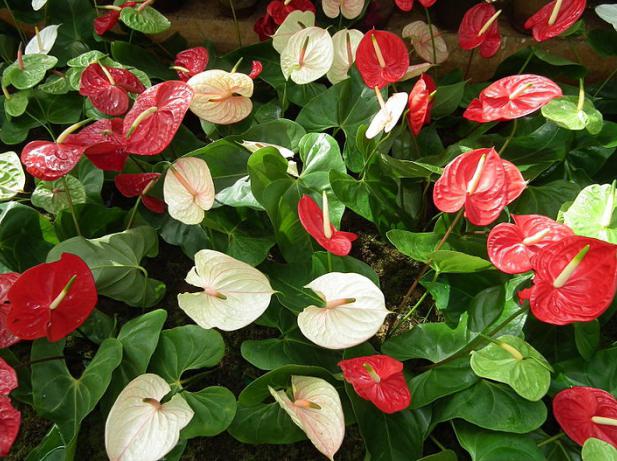
For eight months, blooming anthurium continuously pleases its owner with the beauty of the buds, although some of them bloom for only about 40 days. If you follow all the rules for caring for an exotic handsome man, the plant can grow up to 0.8 m in height and up to 0.5 m in diameter.
4. Varieties of anthurium:
4.1 Anthurium Andre - Anthurium andreanum
A very common showy tropical plant. This type is often used in compositions, wedding bouquets. It is very decorative in a warm period of time. Long-term flowering, almost all year round. The flowers are glossy red, pink, white or orange, heart-shaped, in fact, it is a blanket, with a white ear densely covered with tiny flowers. The leaves of this large anthurium are dark green, long, leathery, located on an upright stem. Bedspreads are able to maintain an attractive appearance for several months. Pollination of flowers significantly reduces the flowering time - in this case, the bedspreads will also lose their decorative effect ahead of time.
↑ Up,
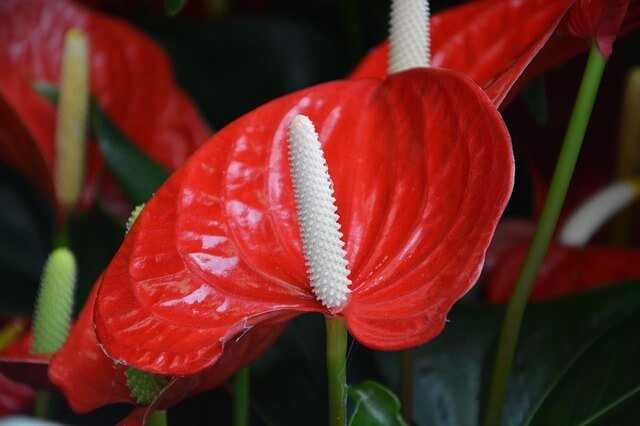

One of the most spectacular varieties of this sub-species is anthurium Amalia - Anthurium Amalia Elegance - a beautiful low plant with emerald - green leaves and flowers, collected in inflorescences - cobs of pink or lilac hue. The main attractiveness of the plant is given by an oblong white blanket with a pink tip and veins surrounding the flowers.
↑ Up,
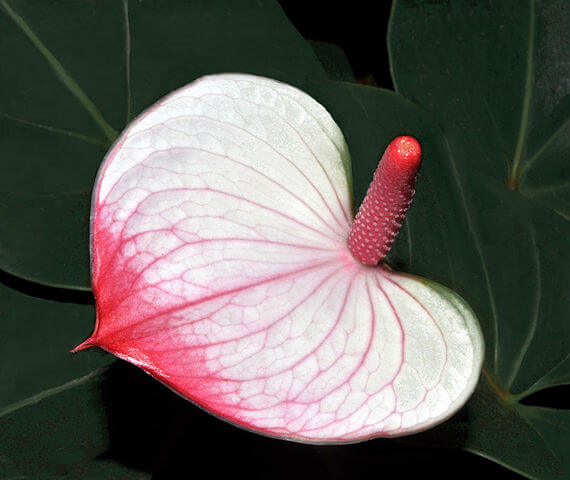

Anthurium Dakota - Anthurium "Dakota«, belonging to the same group, has large, glossy, richly burgundy bedspreads with pronounced veins and yellow inflorescences - cobs, is gigantic in size - can reach a height of 1 m.
↑ Up,
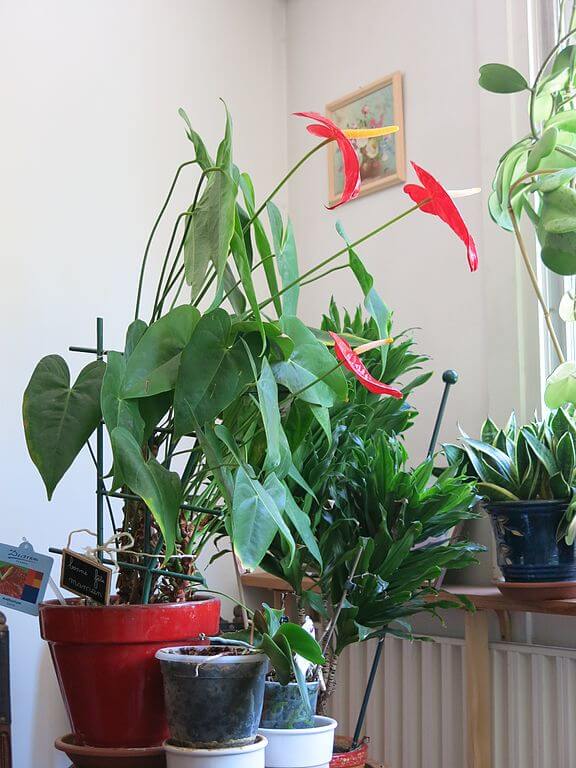

Anthurium Cavalli - Anthurium "Cavalli" - a plant with delicate pink or lilac glossy bedspreads and dark - often even purple cobs on tall leafless peduncles. Looks like him outwardly large-flowered anthurium Fiorino, which is also distinguished by an unusual purple shade of bedspreads, however, bedspreads of this variety are more glossy and oblong, without pronounced veins on the surface.
↑ Up,
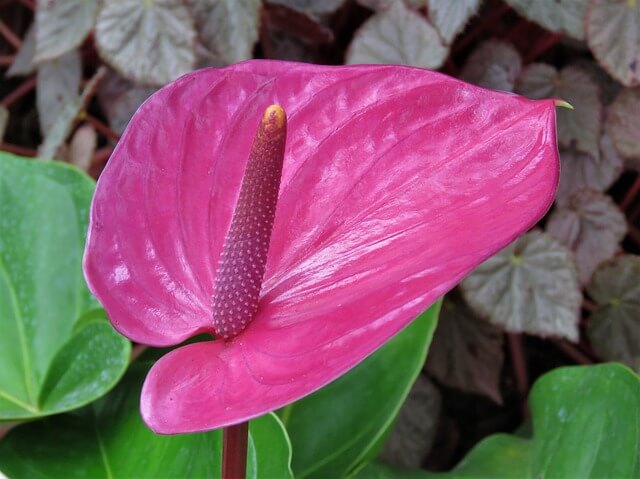

Anthurium Andre Leganza - Anthurium Leganza is a beautiful lush small-leaved bush with dark green leaves and beautiful bedspreads painted in delicate pastel colors - a combination of light green and pink. Inflorescences - the ears are painted in a bright orange or pink hue.
↑ Up,


Anthurium Picasso - Anthurium Picasso - a plant distinguished by an unusual, bright yellow color of the veils, which contrast perfectly with the matte dark green leaves.
Often on the Internet you can find a photo of blue or blue anthurium - such plants do not exist, the dyes with which the bushes are watered or injected directly into the peduncles give a bright shade to the bedspreads.
↑ Up,
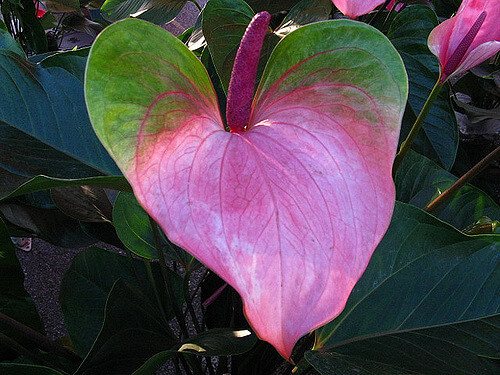

4.2. Anthurium scherzerianum
Also a common species, flowers with a red oval veil, with an orange-colored ear, densely covered with tiny flowers. A distinctive feature of this variety is the inflorescence bent with a spiral - the ear. Flowering lasts about 2 months. Large, pointed, dark green leaves 18 cm long surround upright stems. Unlike Andre anthurium in these plants, the leaves do not have a notch in the place where the petiole is attached, and the cylindrical peduncles inside the cover are bent in the form of a pig's tail.
↑ Up,
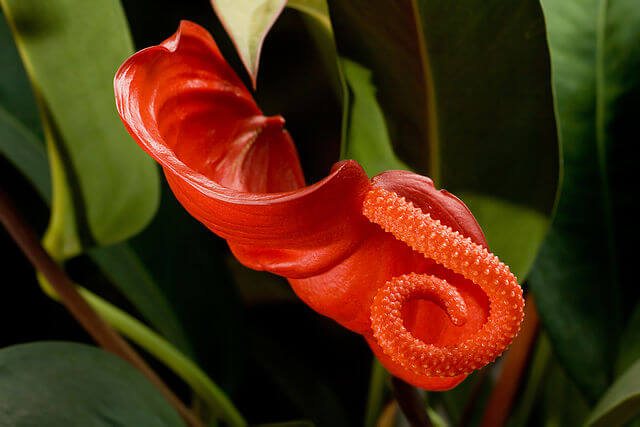

4.3 Anthurium crystallinum
A stunning large-leaved decorative anthurium, which rather belongs to decorative leafy plants. It has large heart-shaped leaves on tall, thick petioles. The leaf blades are dark green, as if velvety, with a bluish bloom. Distinct leaf veins are highlighted with a lighter - silvery shade. The leaves are unusually thick and tough, reaching a length of 50 cm. The flowering is inconspicuous, not of particular interest. The inflorescences of this species are thin, long, yellow, surrounded by small greenish or white veils.
You may also be interested in:
- Gloxinia - flower photo, home care, description of varieties, growing from seeds, flowering time of indoor plants, diseases and pests, leaf propagation, watering, why spots appear on the leaves
- Astilba - photo, planting and care in the open field, description of the flower, varieties and types of plants, use in landscape design, growing at home, flowering time, height, soil selection
- Eustoma - photo of color, growing from seeds, planting and care in the open field and at home, in a pot, what a room lisianthus looks like, soil, varieties, flowering
- Ranunculus - a photo of a flower, planting and care in the open field, growing at home from seeds, keeping in a pot, description, flowering time in a flower bed and at home, description of plant varieties
- Physalis - photo, growing and care in open ground, planting at home, useful properties of berries, what it looks like - description of varieties, growing from seeds, flowering time, fruiting, diseases and pests
↑ Up,
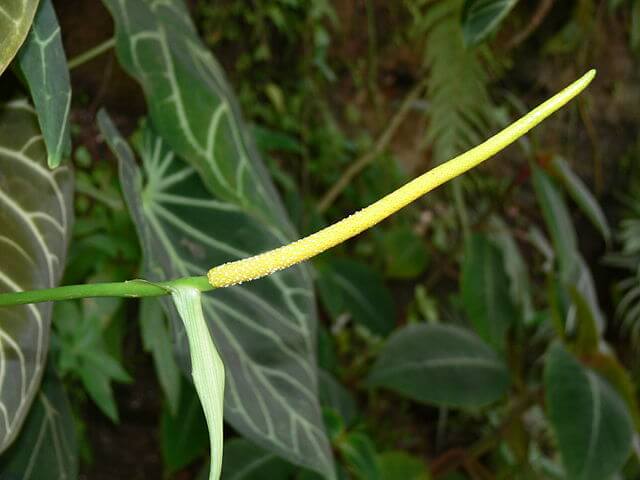

4.4 Anthurium Turenza
Medium-sized flowering evergreen bushes with large, dark green, glossy, heart-shaped leaves on long, thin petioles. The bedspreads are large, bright, pinkish-red. Inflorescences - cobs of cream or yellow shade contrast perfectly with spectacular bedspreads.
↑ Up,
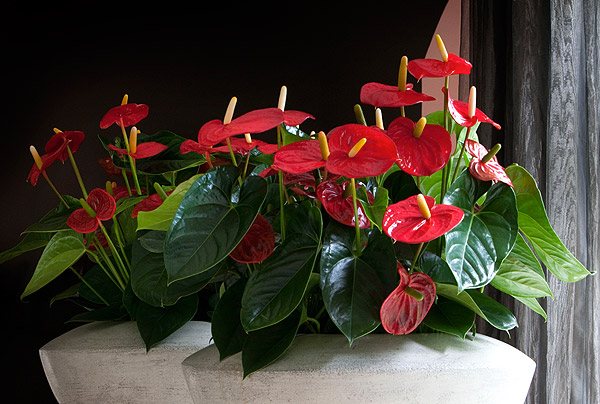

4.5 Anthurium hookeri
Large decorative leafy variant, forming a basal leaf rosette resembling a bird's nest. Leaves are green, glossy, broadly elliptical, on short, strong petioles.The leaf blades have corrugated edges. During the flowering period, erect leafless peduncles appear in the outlet, at the top of each is a narrow, small cover of light green color, surrounding a purple or cream cob. Flowering is of little interest.
↑ Upward,
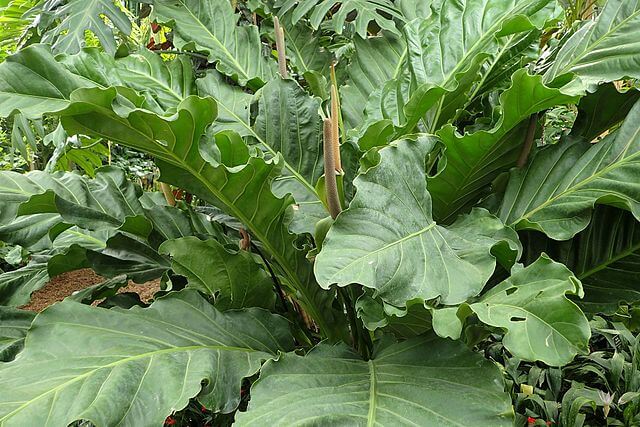

4.6 Anthurium veitchii
Giant, large-leaved epiphytic plant with narrow, cordate, glossy dark green leaves. A wide light stripe runs along the central leaf vein, and the lateral veins are deeply recessed into the leaf plates. When grown under optimal conditions, the leaves can be up to 2 m in length. The flowers are yellow or light green, clustered in cylindrical cobs and surrounded by small greenish blankets.
↑ Upward,
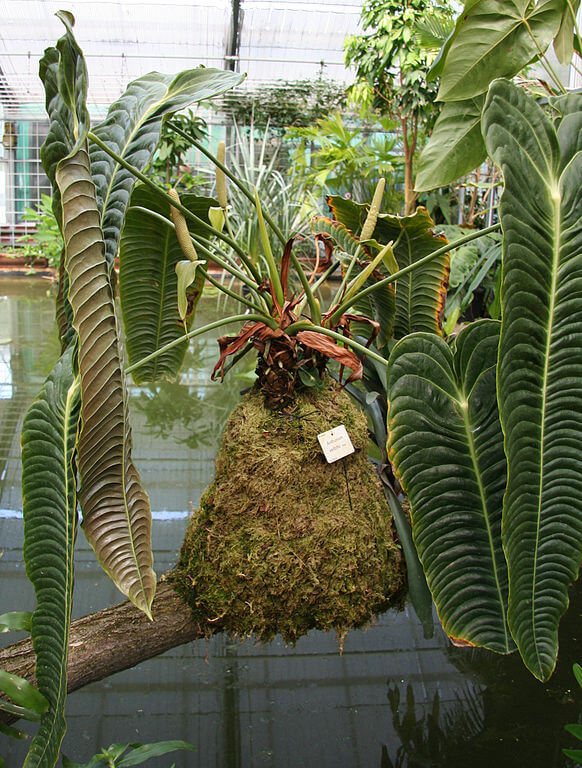

4.7 Anthurium Sumi
A beautifully flowering variety up to 60 cm high. The leaves are dark green, shiny, cordate, on long petioles. Inflorescences are straight pinkish, orange or yellow, surrounded by large, wide, white bedspreads.
↑ Upward,
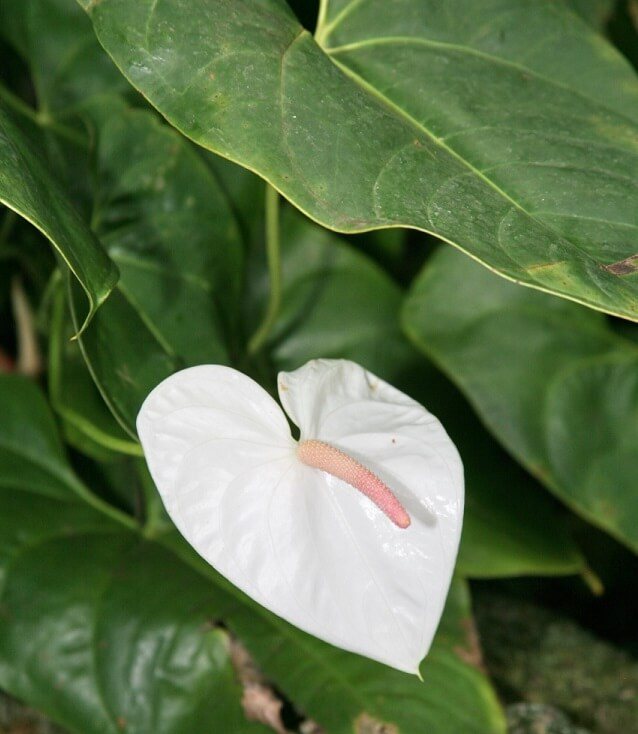

4.8 Anthurium magnificum
Ornamental evergreens with broad, attractive, heart-shaped leaves. The leaves are painted in a dark, bluish-green hue, while the leaf veins are highlighted in a lighter, bluish color. The leaf blades are velvety to the touch, with a lighter tone on the underside. The leaf petioles are long, tetrahedral. Young leaves can have a brownish or bronze tint. The flowering is inconspicuous - this species has probably the smallest, pale green veil of all anthuriums.
↑ Upward,
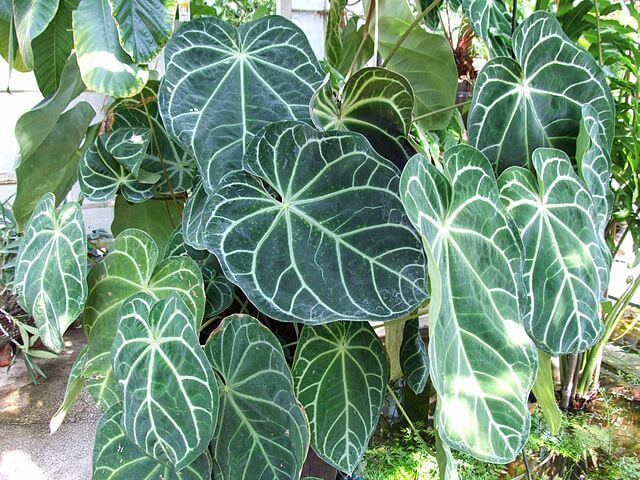

4.9 Anthurium Clarinervium
Bright ornamental plants with large, heart-shaped leaves 15 - 30 cm long. Leaf blades are dark green or bluish green, entire, leaf veins are highlighted with a contrasting light shade - light green or bluish. Young leaves are brown or bronze. The lower surface of the leaves has a lighter shade. The flowering is inconspicuous.
↑ Upward,
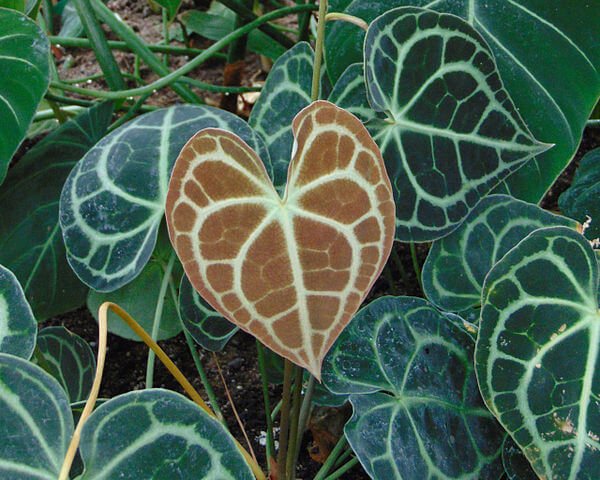

4.10. Anthurium multi-dissected - Anthurium polyschistum
At first glance, it is difficult to attribute this plant to anthuriums - it is so different from them in appearance. In our country this species is not widespread, but in Europe it is a widespread ornamental-leafy plant. The leaves of plants are complex, fan-shaped, on long, light green petioles, adult bushes form stems. Leaf segments are glossy, dark green, narrowly lanceolate or linear. The edges of the segments are covered with indistinctly pronounced denticles, often corrugated. Flowering is of little interest and often goes unnoticed - the long, green ears of these plants are surrounded by light green, narrow bedspreads.
↑ Upward,
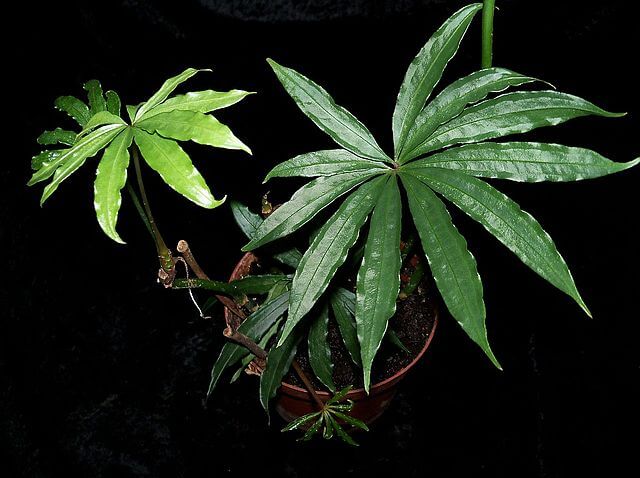

Landing
Anthurium at home grows well and multiplies, if you skillfully approach this matter. To make the flower feel comfortable, choose a pot that is wide, but not deep enough for it. This is necessary for the branched root system to develop normally. Too large a flowerpot is not recommended, as it may be the reason for the lack of inflorescences.
Anthurium does not tolerate excess moisture, excessive moisture leads to decay and death of the entire flower. To avoid this, it is necessary to lay a drainage layer at the bottom of the flowerpot, then fill in part of the earthen mixture, carefully place the plant or seeds and sprinkle with the remaining earth. The mixture is recommended to be prepared from turf soil, pieces of moss and decayed foliage.
Step-by-step instructions with a photo
In principle, there is nothing difficult in the reproduction of anthurium. All parts of the plant are suitable for this. It is important to study the technology in advance and understand whether it is right for your flower.
How to propagate by dividing a large bush
The method is suitable only for adult plants (3-4 years and older). Caring for the anthuriums obtained in this way has no specific features. Is that during the first two to three months, experienced flower growers recommend weekly spray the plant with any biostimulant - Epin, Kornevin, Zircon, Heteroauxin, potassium humate. Ordinary succinic acid will do.
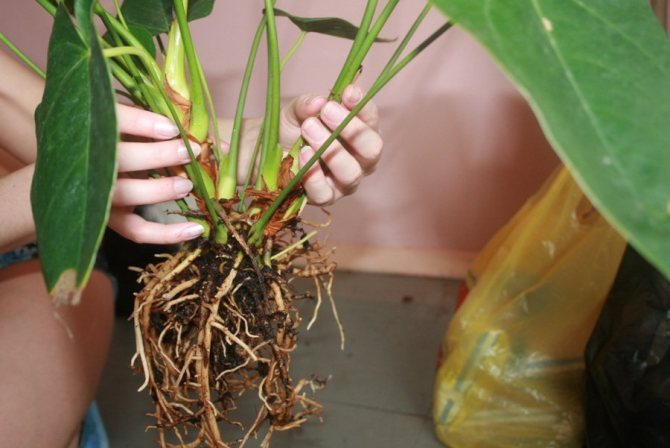

When dividing an anthurium bush, try to untangle the roots with your hands - they are very fragile; cut is very undesirable
The division of the anthurium bush allows not only to get new specimens, but also to significantly rejuvenate the plant. The procedure is carried out at the beginning or in the middle of spring, simultaneously with the next transplant.
- Water the plant abundantly 20-30 minutes before the procedure.
- Remove the anthurium from the pot by tapping lightly on the sides. Shake the substrate off the roots.
- Untangle the roots carefully. They are cut with a knife only as a last resort, because they are very fragile and break easily. "Wounds" are immediately sprinkled with crushed chalk, activated carbon, cinnamon. Each part of the plant must have a growth point, well-developed roots and at least one leaf.
- Get rid of all rotten, dead, dried out roots. Process the sections as described above. Let the plant dry for about an hour outdoors.
- Plant the pieces into new pots using soil suitable for mature plants. In general, this procedure is similar to a transplant. In the process, watch the level of the soil - the roots should be buried in the same way as in the old pot or a little more. They are extremely sensitive. If left outdoors, the plant will quickly become sick and die.
- Tie the anthurium to the support if necessary. It is necessary to estimate in advance whether it will be needed, because it is placed in a pot before the flower is placed there, and not stuck into the ground after the transplant is completed.
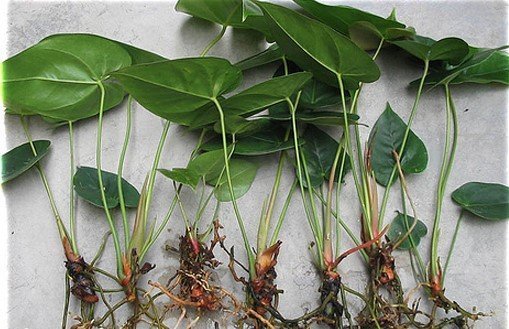

One anthurium bush can make about a dozen new ones - this is a great way to rejuvenate a plant.
Rooting side shoots
Lateral shoots are "offspring" of anthurium. This breeding method is provided by nature itself. Separate the "kids" during the transplant. If you try to remove them from the pot without touching the mother plant, the roots will be severely damaged. An adult anthurium may even die.
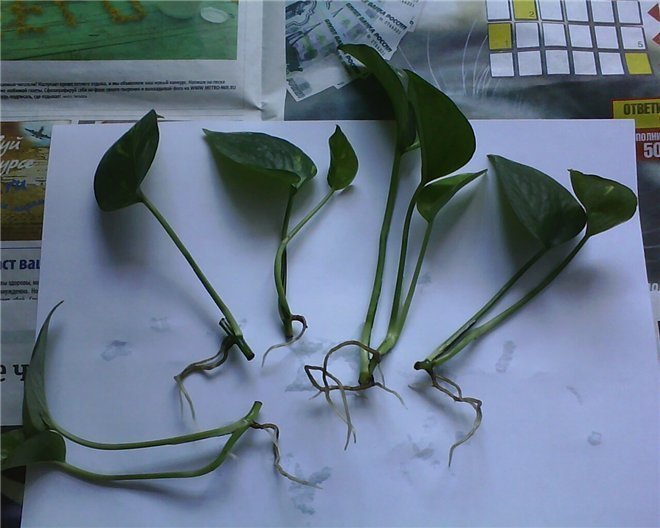

The lateral shoots of anthurium are separated during transplantation, they already have developed roots, so new plants take root quickly
If a transplant is not foreseen in the near future, and the "offspring" is desperately needed, remove the plant from the pot, trying to destroy the earthen lump as little as possible. Manually carefully separate the lateral shoot (always with roots), return the "donor" to its place and add fresh substrate, closing the resulting void.
- Fill small pots with clean sphagnum moss or a mixture of humus and perlite, vermiculite (1: 1). Moisten the substrate well.
- Plant the offspring in the ground. Cover the containers with glass caps, cut off plastic bottles, place in transparent plastic bags, tying them tightly.
- For rooting, anthuriums need a constant temperature of 28–32 ° C and a humidity of 85% and above. Choose the brightest place in the room, but protect the "offspring" from direct sunlight.
- Remove the cover for 10-15 minutes daily, airing the plantings, and spray the soil with a weak solution of a biostimulant (2-3 ml per liter of water).
- Remove the greenhouse after about a month. Place the pot in a permanent place.
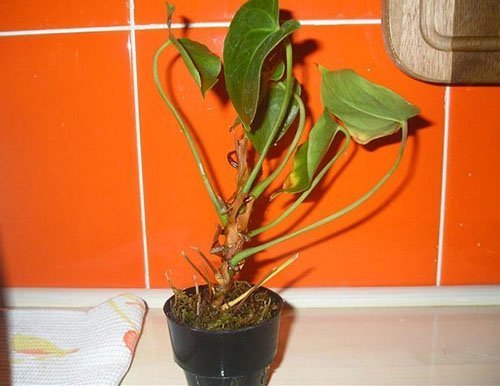

It is the easiest and fastest way to get a new anthurium from a side escape.
Growing "male happiness" from the root
The method is very similar to the previous version, but it takes more time. The roots (healthy and strong) are manually removed from the stem during the transplanting process. They are germinated in clean sand, perlite, vermiculite, constantly maintaining the substrate in a slightly moist state.
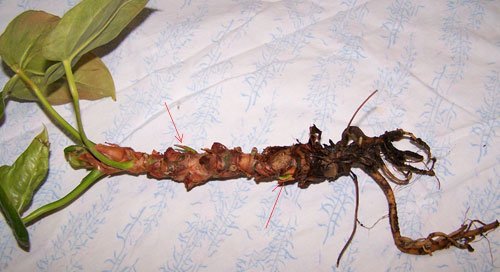

Anthurium roots take a long time to germinate, so this method of propagation is rarely practiced.
The shelter is removed no earlier than 1-2 true leaves appear. The process usually takes 1.5–2 months. After another month, you can transplant the plant into soil for adult anthuriums.
Cuttings
The easiest way to get a new anthurium. At home, they resort to it most often. Planting material from a plant can be taken at any convenient time, but the best period for this is late spring or early summer. To do this, choose stems 12 cm or more long, on which there are at least two leaves.
Anthurium stalk - a leaf cut along with a part of the stem. Only the bottom 5–8 cm will be needed, so the sheet plate itself can be removed.
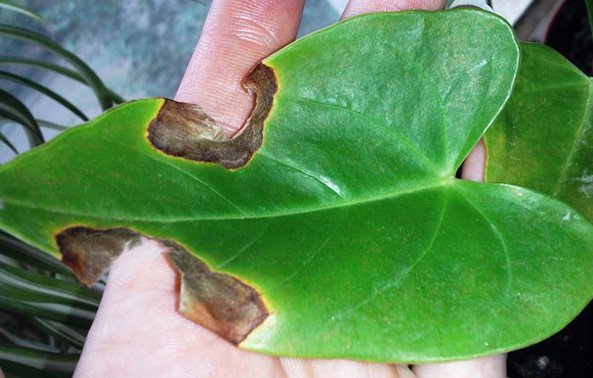

For grafting, only perfectly healthy leaves are chosen, without the slightest traces of disease and pests
- Sprinkle the "wound" on the mother plant with crushed chalk, colloidal sulfur, sifted wood ash, or grease with green stuff, iodine.
- Dry the cuttings outdoors for 10-15 minutes.
- Plant them in small cups filled with a mixture of sand and peat chips (1: 1) or sphagnum moss. Previously, drainage holes must be made in them. The substrate must be dry. An alternative is to germinate the roots in water. It should be soft, warmed to room temperature. The fluid must be changed daily. To speed up the process, the water is replaced with a weak solution of a rooting stimulator, and the base of the cutting is sprinkled with any powdery preparation of a similar action before being placed in the substrate. Do not deepen the planting material too deeply - only the bottom 4–5 cm should be in the substrate or in the water.
- Cover containers with cuttings with plastic bags, glass caps, ensure the temperature is 25-28 ° C, bright diffused light and humidity of about 80%. Moisten the substrate every 2-3 days without letting it dry out, even the top layer.
- Root buds will appear in a week. When they reach a length of 2–3 cm (after about 30–40 days), anthuriums can be transplanted into soil suitable for mature plants. At first, a pot with a diameter of no more than 10 cm is enough.
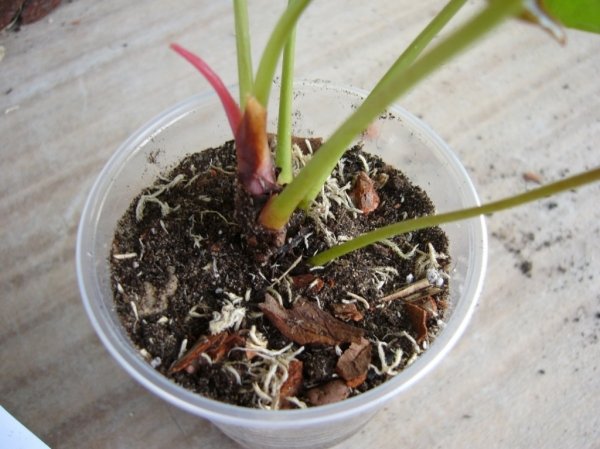

For greater "bushiness" in one container, you can plant several rooted cuttings of anthurium
Germinating seeds
The method is not very popular with amateur flower growers. First, the procedure is quite time consuming, and success is not guaranteed. Secondly, it is not a fact that the plant obtained from seeds will retain the varietal characteristics of the "parent". Especially if it is an artificially bred hybrid. But on the other hand, this is a unique opportunity to act as a breeder and become the happy owner of an anthurium that no one else has. The flowering of such a specimen will have to wait at least three years.
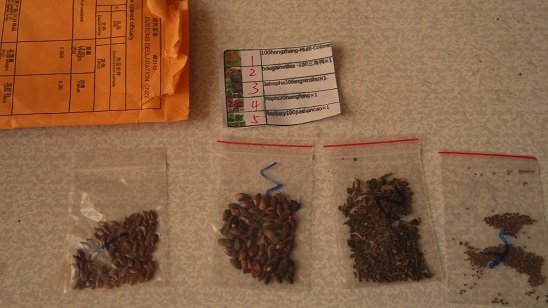

Anthurium seeds can be purchased or obtained at home
The seeds can be purchased from specialized stores without any problems. Be sure to pay attention to the expiration date. Six months after harvesting, it makes no sense to plant them, germination is very short-lived. It is best to use seeds harvested at least three months before purchase.
Planting material can also be obtained at home. This requires at least two anthuriums. When one of them blooms, brush over the "cob" with a soft brush, brushing off the pollen on a sheet of paper. Put the collected in the refrigerator.
Wait until the ear appears on the second plant and cross-pollinate (at the very beginning of flowering). The best time for this is a sunny morning. Using a cotton pad or fingers, spread the pollen, moving first from the bottom up, then in the opposite direction. Repeat the procedure every day. Four or five times should be enough. In principle, you can try to pollinate the anthurium with your own pollen, but the likelihood of success is low.
After about a month, the ear will begin to swell. It will take 9-12 months for the fruit to fully ripen. When the coverlet turns green, the inflorescence is greenish-brown, and the darkest berries look like they are about to fall out of it, remove the fruits. Remove the top shell, dry the seeds in the open air for 2-3 days, no more. Sow them as soon as possible.
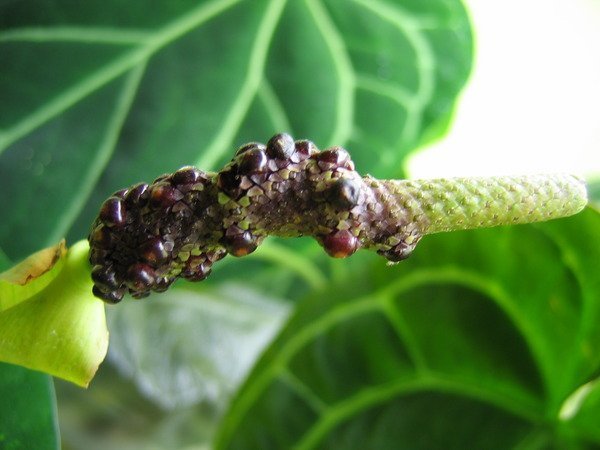

Ripe anthurium fruits look like this
Video: ripening anthurium seeds
- Fill a shallow bowl with peat chips, moisten and level the substrate. Let the moisture absorb.
- Soak the planting material in a pale pink solution of potassium permanganate for 10-15 minutes. Then spread on a napkin or soft cloth to absorb excess moisture.
- Spread the seeds evenly over the surface, sprinkle with soil a little (layer no more than 2-3 mm thick). Cover the container with glass or plastic wrap.
- Provide bottom heating, temperature around 25 ° C, bright ambient light. Open the "greenhouse" daily for 5-7 minutes to ventilate, as it dries, spray the soil with a fine spray gun.
- The first shoots appear in a week, mass shoots - in 12-15 days. When the first true leaf forms (about a month later), remove the greenhouse.
- Plant the plants with three leaves in separate cups with a diameter of 7-10 cm, filled with a mixture of peat, leaf earth and powdered charcoal (in equal proportions). Drainage is required, filling at least a third of the volume of the pot.
- Take care of young anthuriums as usual. Only when feeding for six months, reduce the concentration of fertilizer in the solution by half compared with that recommended by the manufacturer.
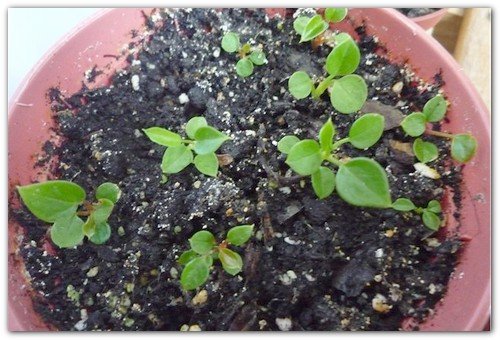

So anthuriums grown from seeds look after about 3-4 months, you will have to wait at least three years for flowering
Video: anthurium from seeds
Leaf propagation
The method is not suitable for all plant species. Thus, the anthuriums of Scherzer, Andre, leathery and other varieties with thick prominent veins on the leaves multiply.
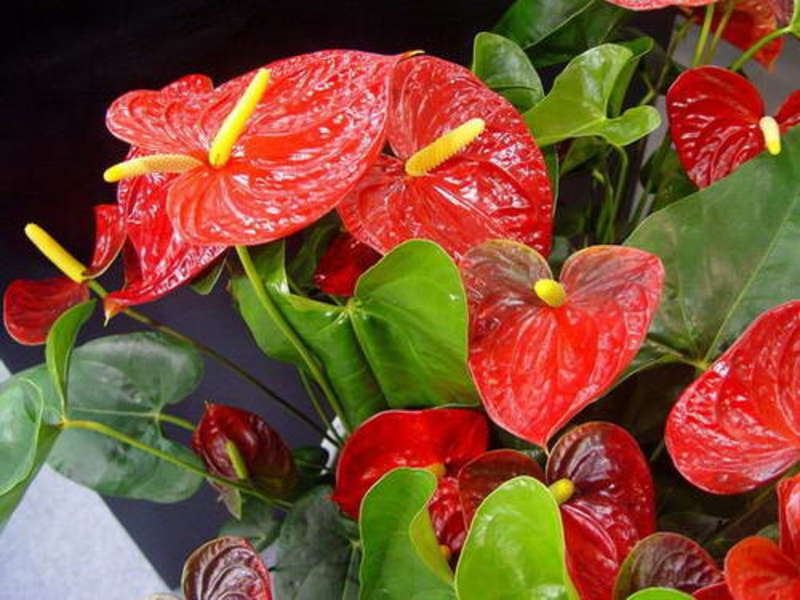

Anthurium Andre (the most popular among amateur flower growers) is quite suitable for leaf propagation
- Cut the leaf together with a part of the petiole about 3 cm long.
- Roll it up with a tube or funnel, tighten with a thin elastic band or thread. Do not over tighten.
- Fill small deep pots with a mixture of peat, sand, perlite, vermiculite (1: 1). Dip the leaves 2/3 into the ground. An alternative is germination in boiled water at room temperature. It does not need to be defended, but it will have to be changed daily.
- Water the plantings and cover the containers with glass caps or plastic bags.
- Place the pots in a light partial shade, maintain a temperature of 25–27 ° C. No bottom heating required. Air the plantings daily, spray the substrate with a weak solution of a rooting stimulator.
- After 20-25 days, a sprout should appear from the middle of the funnel. Wait another month and transplant the young anthurium into the soil for mature plants.
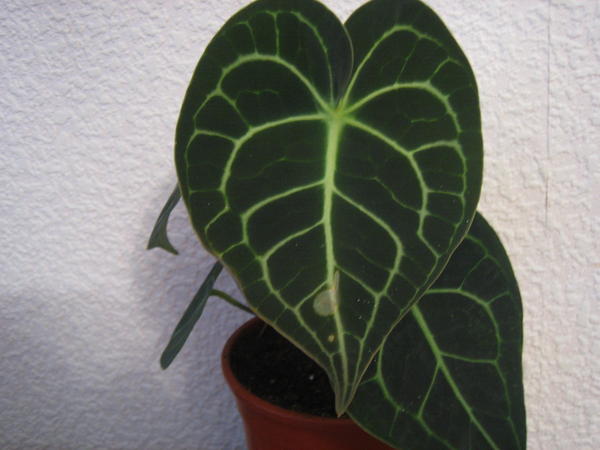

For leaf propagation, anthurium species are best suited, in which veins are sharply distinguished
How to care for anthurium
Anthurium is considered one of the most beautiful flowers. We will now consider in detail how to care for this beauty. The very first thing I want to say is that "male happiness" in our latitudes can be grown only in indoor conditions. Before moving on to the rules and features of care, it will not be superfluous to note that this flower cannot be called simple and unpretentious. He is very moody, requires a lot of attention to himself, but in return he gives beautiful inflorescences and, according to legends and beliefs, happiness and well-being at home.
When caring for anthurium, special attention should be paid to watering and moisturizing. The plant is very fond of the "shower" from the spray bottle, but it must be remembered that excess moisture is fatal for it.Therefore, you need to spray very carefully so that water droplets fall only on the leaves. If flowers get caught in this kind of rain, they can become stained and fall off. It is recommended to install a humidifier in rooms where "male happiness" lives, especially when the heating season begins.
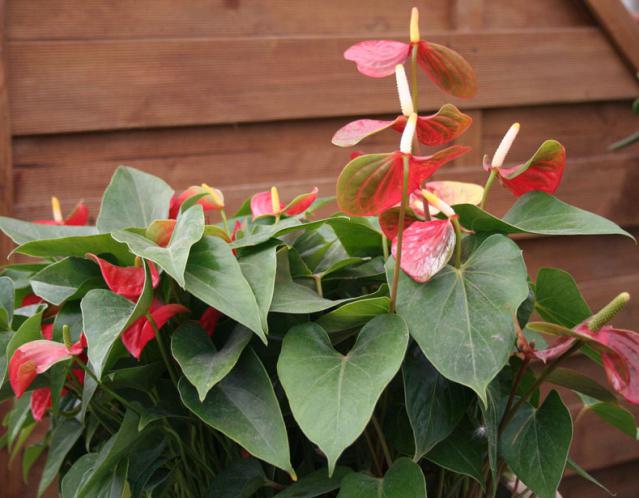

Now let's talk about watering. Too often it is prohibited. In summer, it is recommended to water once every 4 days, and in winter - once every 7 days. It is also not necessary to pour too much, as the roots are very sensitive to water and can immediately begin to rot. The plant will immediately signal such a danger by blackening the leaves. In this case, you need to urgently stop watering and dry the ground in the flowerpot. This way the flower can be saved.
Continuing the theme of water, we note the fact that anthurium is a flower that does not like hard water. He will react especially badly if you decide to sprinkle him with water just drawn from the tap. The result of such an oversight will be the absence of flowering and drying of the leaves. Before watering, the water must be defended.
When caring for "male happiness", you must also remember about feeding. If you fertilize anthurium on time and correctly, according to the instructions, it will grow strong and beautiful. This should be done monthly, starting in March and ending in November.
Transfer
"Male happiness" requires constant transplantation. It is definitely worth replanting it immediately after purchasing the purchase, choosing the optimal pot and soil composition. A young flower needs to be transplanted once a year, and as it grows up, cut to once every two to three years.
During this action, you need to be extremely careful, because Anthurium is a very fragile flower, and its roots are sensitive to any damage. If it turned out that you touched the root, then fill the wound with activated carbon.
Advice! If you have never transplanted flowers, then ask your friend who has a similar experience to be present. This will eliminate the possibility of mistakes, and the advice of an experienced grower will come in handy.
Hold the plant gently and cover the pot with a special mixture of soil, moss and earth. Try to disturb the plant as little as possible. After transplanting, the plant should be watered abundantly so that the water tampers the ground and calms the stressed plant.
Find out more in the video:
Reproduction of anthurium at home
Anthurium ("male happiness") is best propagated by dividing the bush into several parts. You can still grow a plant from seeds, but this method is more complicated, and, naturally, you will have to wait longer for beautiful inflorescences.
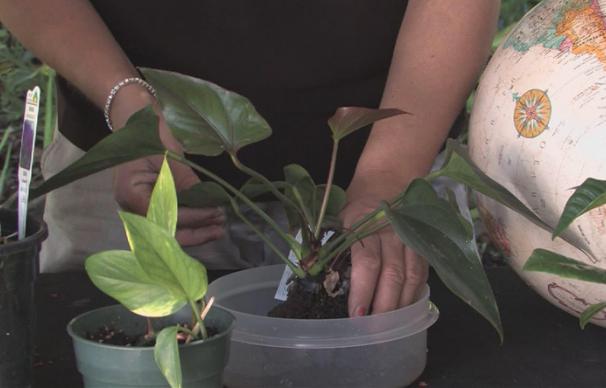

Dividing the bush will not only allow the anthurium to propagate, thanks to this procedure, the plant will retain its youth longer. It is recommended to do this every year, dividing the bush into 2-3 parts.
Reproduction
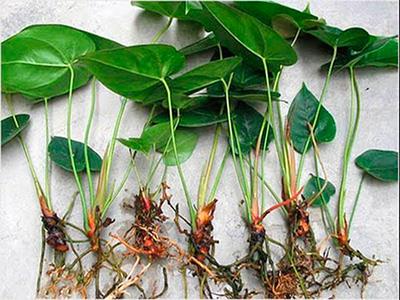

Plant propagation needs to be approached with special care. A mistake can lead to the fact that he will die. Inexperienced housewives are not recommended to deal with this issue on their own.
There are several ways to breed:
- Using the top, carefully cutting it off the stem and rooting it in a container of water;
- Stem suckers sprouting on the roots;
- Having resorted to dividing the roots of the birthing bush with a sharp knife.
Where to "settle" anthurium
Some flower lovers, having learned that anthurium ("male happiness") comes from South America, where the sun is hot and sometimes merciless, they put a flowerpot with this southern handsome man in a place completely open to the sun's rays. This is a big mistake, since anthurium does not tolerate direct sunlight and any other bright lighting. If in the summer you do not hide the flower in the shade in time, then its leaves will receive sunburn.
With the onset of winter, "male happiness" is recommended to be placed in a well-lit place.Thus, the plant will be able to stock up on strength for future flowering. If in the cold season the anthurium feels a lack of sunlight, then it may well turn yellow.
The humidity in the room should be high, while the air temperature should be relatively low (+18. +20 degrees, not higher).
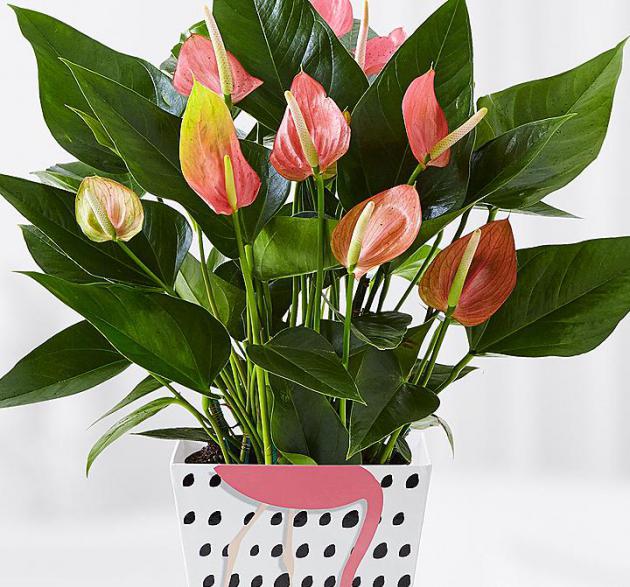

Frequent mistakes
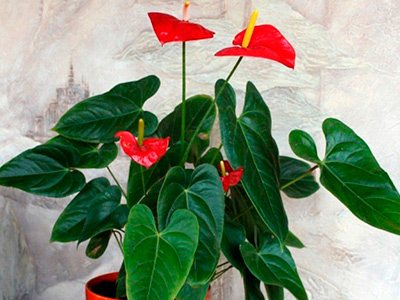

Since anthurium is a tropical plant, many growers try to provide it with enough light. They often do it in too much excess. From the bright light "Male happiness" immediately perishes.- In winter, the plant does not receive enough heat. From the cold, rotten spots immediately appear on the leaves, the appearance of the flower becomes lethargic, weak. The air temperature should not fall below 15 degrees.
- Many inexperienced overflow the plant, which leads to root rot. This is not worth doing.
Useful properties of a flower
An interesting fact is that anthurium ("male happiness") gives people not only its beauty, this plant also brings considerable benefits to human health and to cleanse the environment:
- Anthurium reduces the total content of microbes in the air of the room by 70%, cleans the atmosphere from formaldehyde by 7.3%, as well as from ammonia and toluene.
- In folk medicine, the roots of some types of anthurium are used to prepare a medicine for headaches.
- Volatile secretions of the plant suppress the development of streptococcus, staphylococcus and Pseudomonas aeruginosa.
- Anthurium (A. acutangulum) can be used to make a tea that helps with whooping cough.
Background
The legend of the flower was born in India (some sources indicate North America). In those days, people were tough. There was a tribe where the leader was a heartless man. One day he saw a beautiful girl and decided that she would become his wife. But the young lady rejected the leader. However, he did not retreat and went to war against the tribe of the girl. In this way, he conquered the girl. A festive bonfire was lit on the wedding day. The girl did not want to put up with her sad fate and decided to commit suicide. The young lady jumped into the fire. At that moment she was wearing a red dress. The gods took pity on the beauty and turned her into a bright flower. Since then, the village has been overgrown with dense forest. Only one unusual flower is visible among the grass. Every day its leaves are covered with dew. These are the bitter tears of that girl's relatives.
Flower properties
Anthurium
- this is one of the most spectacular home
flowers
popularly called -
Male happiness
... And this is absolutely no coincidence. There is a belief that this flower gives a man confidence, masculine strength and courage. And he will help women to quickly marry a worthy man. Once in the house of an unmarried girl,
Anthurium
able to attract the flow of male energy in the most amazing way.
According to the signs, if you start such a plant at home, then prosperity, prosperity and happiness will always reign in it. An excellent solution would be if you place next to it Spathiphyllum (Women's happiness)
... Standing nearby, these flowers are able to harmonize the relationship between a man and a woman. The magical energy of these two plants is able to give mutual understanding to those who suffer from frequent conflicts. The attentive attitude of the owners and the care of flowers can significantly increase the well-being of the family.
In addition, if for Anthurium
proper care will be carried out, then the flower will certainly delight the owners with its wonderful flowering and an excellent decoration in the house.
The amazing beauty of the plant is given by the bright red color of the cob, resembling the shape of a heart and stunning glossy petals, as if made of wax.
Anthurium
differs from other colors in its bright, not quite usual shape. He is able to bewitch and draw attention to himself. Due to its unusual appearance, the flower has received many different names:
Artist's palette, Pigtail, Devil's tail.
Some types of plants can relieve depression, help to distract from sad thoughts and calm the nerves. The flower is able to give peace and spiritual idyll. Anthurium
makes the mind clear and the consciousness clear. The plant contributes to the fact that young people can find their soul mate in a very short time, and successful married couples can find harmony and happiness in relationships.
Popular superstitions and omens
Anthurium is a flower quite famous among the people. For this reason, many interesting signs have appeared around him. The following superstitions are considered the most popular:
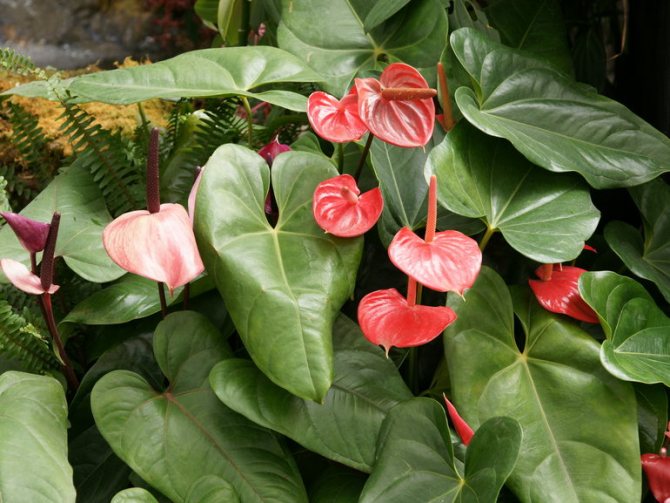

- If the husband and wife decide to divorce or simply do not get along with each other, you need to buy an anthurium. There is an opinion that he is supposedly able to restore relations between them and bring freshness to them. Anthurium also promotes fidelity.
- The plant helps single women. To do this, they need to go to the store and buy the Male Happiness plant. At the same time, it is important that a man sell it without fail.
- Culture can also help solve money problems. To do this, it is again necessary to purchase a flower that will allow money to easily and without problems come to the owner's house.
The flower is sometimes referred to as "female happiness." It symbolizes the appearance of a life partner for the fair sex. There is a lot of talk among the people about his ability to "drive away" depression.
There is a belief that the presence of a plant in the house makes it possible to normalize the psychological state of the owner. There are also rumors that it is supposedly able to strengthen the body's defenses and cleanse the air of harmful components.
Botanical description
Anthurium
originally from South America. It has about 80 hybrids and about 30 subspecies. This plant was introduced in the 19th century. and became very popular in a short time.
IN Anthurium
the most important and unusual is its flower. It has an original appearance of cobs of yellow and white shades, which are framed by bedspreads of various colors, from pink to deep red.
Anthurium Leaves
can grow up to 40 centimeters. They are quite long, heart-shaped.
Flowering period of Anthurium
is more than half a year, from March to November. After that, he has a short rest, after which the flowering period begins again. But this happens only when the plant is properly and properly cared for.
Anthurium
can grow up to 80 centimeters at home.
Pruning
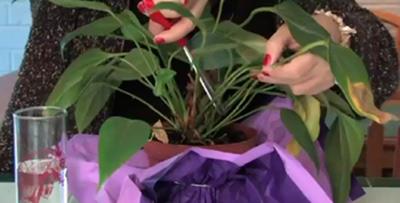

After the flowering period, when the buds have lost their vitality, they need to be cut.
This should be done with caution. Take a sharpened knife and cut the flower at the very base of the bud. The wound can be sprinkled with activated charcoal.
You can wait for the inflorescence cover to dry and carefully remove it. The core itself will dry out over time and move away from the flower without any problems.
Plant care after purchase
Having decided to start this particular plant, you should find out in advance all the nuances for the care of Anthurium at home.
First of all, you should choose the right container for it.
The flower pot should be tight enough. Anthurium does not like wide space
, since he has to spend all his energy on growing roots, and the soil can acidify. At the same time, his leaves will remain rare, and the flowering of the plant can never be expected.
If the pot is large in length, then, on the contrary, it is even better, there will be the necessary space for its roots. In this case, the stems will be abundantly and evenly covered with foliage.
It is recommended to change the soil in the flowerpot annually, as soon as spring comes. The flowering of the plant will depend on this. The flower is very fond of oxygen.
It is recommended to always make small holes on the sides of the pot to allow oxygen flow to the roots. In flower shops you can always buy ready-made soil for Anthurium
.
Top dressing
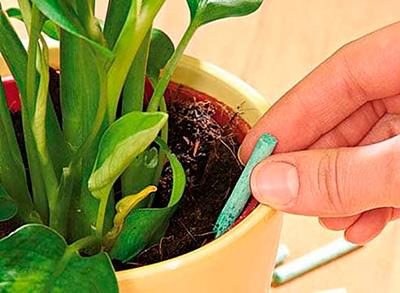

Just watering and creating a favorable environment for Anthurium will not be enough.
In order for the plant to have large lush foliage, to please the owners with flowering, you need to additionally feed it in other ways.
This along the way can eliminate the occurrence of diseases and deal with pests.
In the summer, starting in March, the plant is periodically fertilized with solutions of mineral and organic fertilizers. This should be done once every two weeks, periodically alternating between solutions.
You can buy special food at the flower shop, where they will give you a special mixture designed specifically for this species. The package usually says how often and in what quantities to apply the fertilizer.
Flower care at home
Any plant requires attention and care. The more correctly all the rules for caring for the plant are followed, the longer it will be able to delight you with its appearance, flowering and health.
Soil selection
The plant loves slightly acidic soils. Prepare the soil in the ratio of two parts of humus, one part of leafy land, one part of peat, half part of sand.
For better air permeability, a good layer of expanded clay or pieces of polystyrene, as well as charcoal, should be poured on the bottom of the flowerpot.
There is another way to prepare the composition of the soil for Anthurium
... One part of the sod land should be mixed with two parts of peat and one part of sphagnum moss with the addition of sand.
Temperature regime
Anthurium
loves warmth very much, because it is a tropical culture. Therefore, the temperature for him in the room should be from +15 to +28 degrees.
The plant absolutely does not tolerate drafts, which are very destructive for it. You must always remember this and avoid such disasters for your tropical pet.
Watering Anthurium
Watering the flower is a very important factor. Since this plant came to us from the tropics, it means that it is very fond of abundant moisture. When watering, the water should thoroughly soak the lump, but try not to flood your flower.
In the warm season, in the summer, Anthurium
watered no more than once every three days. It is always necessary to carefully monitor so that water does not accumulate or stagnate in the pan of the pot, otherwise the roots of the plant may rot. Stagnant water can also usually lead to mold growth.
In winter, it is necessary to reduce watering, but at the same time watch all the time so that the soil in the pot does not dry out. In winter, it is enough to water the flower once every ten days.
For irrigation, always use settled water at room temperature.
Air humidity
Anthurium
loves humid air, which prevails in its tropical habitats, as well as high air temperature.
It is necessary to provide him with decent hydration. However, do not overdo it, as the roots can start to rot from the excess amount of water.
You need to put it under the pot with Anthurium
a pallet to be filled with damp pebbles.
Spray the crown of the plant from time to time with a spray bottle. And you can also wipe the leaves with a damp cloth. Make sure that water never gets on its inflorescences.
Flowering conditions
To get this finicky to please you with beautiful buds, you need to constantly keep it in conditions suitable for existence. In addition, you need to pamper the plant with supplements and vitamins.
- Watering Anthurium is better with settled filtered water at room temperature. Water should be free of impurities. Avoid stagnant water.
- Cover the topsoil with sphagnum to prevent it from drying out in the heat.
- If you decide to put the pot on a south-facing window, darken it with tulle or move it to the corner of the window.
- In winter, the plant needs to provide additional artificial light. You can direct the beams of a table lamp at it.
- Frequent rearrangement of a flower can be detrimental to it. This is best done 2 times a year. In spring and autumn.
- If "Man's Happiness" began to bloom, then remove it to a dark place, hiding it from bright rays of light.
- During the flowering period, watering the flower is increased. Do not forget about periodically spraying the leaves and stems with a spray bottle.
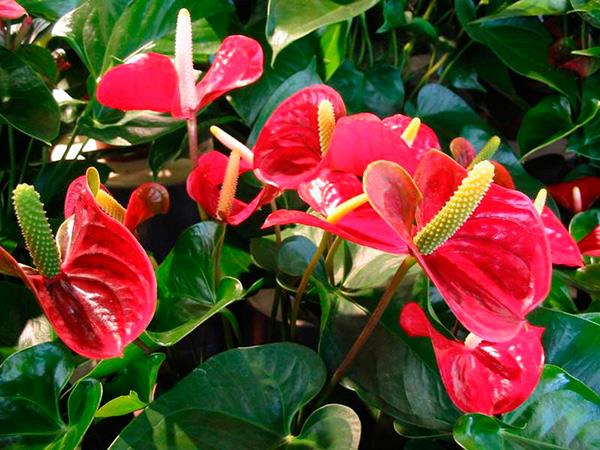

Flower diseases
1. If the tips of the leaves are on Anthurium
darkened, it means that an excessive amount of lime predominates in the soil.
2. The appeared black dots on the flower indicate that the plant is experiencing a lack of heat for a long time. If the plant is not warmed up in time, it will certainly undergo wilting.
3. If the leaves on the plant turn yellow, then it is experiencing a moisture deficit or the plant was attacked by orange aphids, which are removed with a solution of pyrethrum, actellic and karbofos.
4. Cracked leaves and dark spots are indicative of a mealy worm. A drug such as karbofos will help get rid of it.
5. Gray bloom and yellow leaves on the plant indicate that there is stagnant moisture in the soil. Topsin will save the plant from this misfortune.
6. If a sticky bloom has appeared on the flower, this indicates the appearance of a scale insect on it. The plant must be treated with soapy water.
If the care of the tropical handsome man is carried out correctly, then this will prevent the flower from many of the listed diseases, and the timely treatment will protect the plant from its death.
Flowering culture
Many indoor plant owners dream of achieving anthurium flowering. If this can be done, you can get an inflorescence-cob with "tongues" of a bright fiery shade. The bract is in the shape of an arrow or heart, as if enveloping the inflorescences. The leaves have a velvet finish and are distinguished by a dark emerald color. If the ear turns green, this indicates that the flower has faded. This is considered normal.
It also happens that buds appear, but the flower does not form. This problem worries mostly inexperienced florists. This phenomenon indicates that the plant lacks nutrients and moisture. To avoid such problems, it is necessary to feed them in a timely manner with means with the correct composition. Anthurium is not so capricious about the lack of mineral components, but in the case of a prolonged absence of fertilizers, it can react negatively.
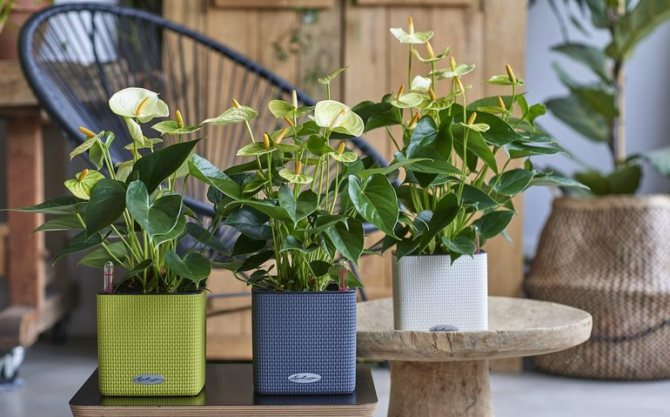

Breeding method
Anthurium
, as a rule, they are planted when it already grows and daughter stems appear near it. This procedure is done when transplanting a plant so as not to expose it to stress once again.
It is necessary to carefully separate the lateral plants from the main one, while at the same time try to untangle the roots so that they cannot be injured.
If you accidentally damage the root system, then it should be treated with activated carbon dissolved in water for disinfection. After that, all the actions will follow, as when transplanting a plant.
Plant transplant
Anthurium
it is necessary to constantly replant. The most suitable time for transplanting it is spring (usually this is done in mid-March), while you should not pay attention to the fact that the plant has released a peduncle. In the first five years, Anthurium is transplanted annually. After - it is necessary to focus on the condition of the flower, as a rule, it is once every three or four years.
If you do not carry out a permanent transplant of a flower, then its leaves can begin to change in color and even begin to turn black. And the peduncle of a plant can become small and will soon wither.
For a normal plant transplant, you must strictly follow the basic rules:
1. Grasp the plant at the base with your hand and pull it out of the pot.
2. The soil remaining between the roots must be removed with a wooden stick.
3. Now you should wash the roots in water. Just be very careful when doing this, because the roots and the plant itself are very fragile. It is best to use a bowl.
4. Next, you should stimulate the growth of the root system. To do this, dissolve half a Heteroauxin tablet in two and a half liters of water and immerse the flower in the resulting solution for about two and a half hours.
5. Now you should prepare a pot for transplant Anthurium
... First of all, a drainage layer is poured: expanded clay, broken foam, pieces of broken brick.
6. Next, add a layer of suitable potting mix. Moisten it a little to shrink.
7. Now you need to place the flower in the middle of the container and fill the soil on the sides of the stem, while tamping it tightly with your hand. Above the very base of the roots, soil should be poured about one and a half fingers thick. If you do not take this step, your plant may simply die.
8. It remains to water abundantly Anthurium
and spray it with an anti-stress solution for plants (Epin-Extra).
Rejuvenation
Over time, the flower can lose its beautiful appearance, overgrow with growths near the roots and lose some of the lower leaves. Along the way, the aging process is often accompanied by the proliferation of small leaves and flowers, and sometimes the complete absence of buds.
If you find such signs, then you need to resort to the rejuvenation of "Male Happiness". The most popular method is a special plant transplant.
The flower has aerial roots under the leaves. It is necessary to carefully cut off the top with leaves, capturing several shoots of roots located above the soil. This part is transplanted into fresh soil, rooted and watered. You can find out more in the video below:
Why doesn't Anthurium bloom?
If your beloved pet does not want to please with its flowering in any way, then you have miscalculated somewhere in caring for it. Errors to watch out for:
1. The room is too cold for Anthurium
... The temperature of 15 degrees is extremely uncomfortable for the plant.
2. Poor lighting.
3. The container is too large for Anthurium
.
4. Overdose of mineral fertilizers. This is primarily indicated by the blackened tips of the leaves.
5. Unsuitable or poor quality soil. In this case, try to transplant the plant into another pot.
6. Plant filling. In this case, its leaves may acquire a distinct yellow tint.
The last two factors may also indicate a fungus that has settled on the plant.
Reproduction methods
Anthurium can be propagated in various ways. Each grower chooses the most optimal and convenient method for himself. What options can be considered:
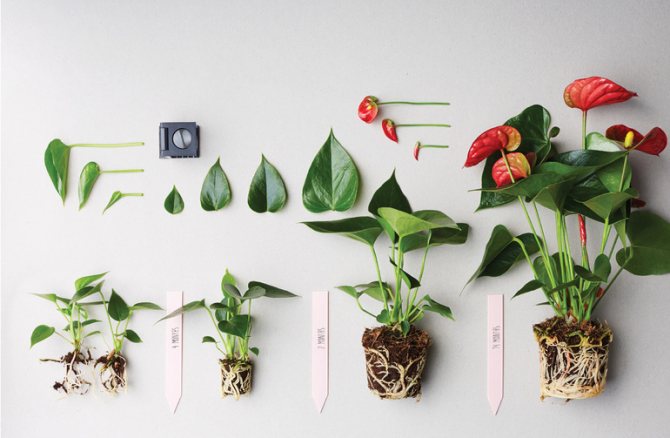

- Cuttings. The simplest method that is available even to a beginner in the field of floriculture. The top is cut off from the mother bush, and then placed in a container with vermiculite. She should have several sheets. The length of the cutting is also important. It should be at least 15 cm. The stem should be deepened to the 5 cm mark. After that, it is covered with cellophane and left for rooting. This goal is achieved after 30 days.
- Division. This method is also common. To propagate anutrium in this way, planting material is prepared. To do this, select several strong shoots and cut them off. After that, they are planted in a pre-prepared pot.
- Seeds. Anthurium can reproduce this way, but this method is not very popular, since it does not provide optimal germination. In addition, this option is time consuming and requires a long wait. Pollination precedes the moment of receiving seeds.To do this, take a brush, transfer pollen particles from one inflorescence to another. If everything is done correctly, after a while a fruit will appear on the bud. After full maturation, it must be removed. This must be done carefully to prevent shedding of seeds.
If a florist decides to use the seed propagation method, he will have to wait for the fruit to ripen for more than six months. After that, you need to remove the resulting box and thoroughly clean and wash it in a solution of potassium permanganate. Following this, it is necessary to put a loose substrate in a pot and place the seeds in greenhouse conditions for 3 weeks. After the specified period, the first shoots will appear. Next, it remains to make a pick of the sprouts and take care of them, as for adult specimens.
general information
Anthurium, or "male happiness" flower, is a representative of the aroid family, found in our nature in the tropics of Central and South America, there are more than five hundred species of anthuriums.
Anthurium is interesting to flower growers primarily for its colorful "flowers", although there are decorative leafy species. More specifically, what in everyday life we sometimes call an anthurium flower is not the flower itself, but its veil, a specific "sail", the flower itself is a cone-cob of white color and without its catchy heart-shaped veil it looks rather ordinary-looking. When the flower fades, the veil turns green - it becomes a leaf.
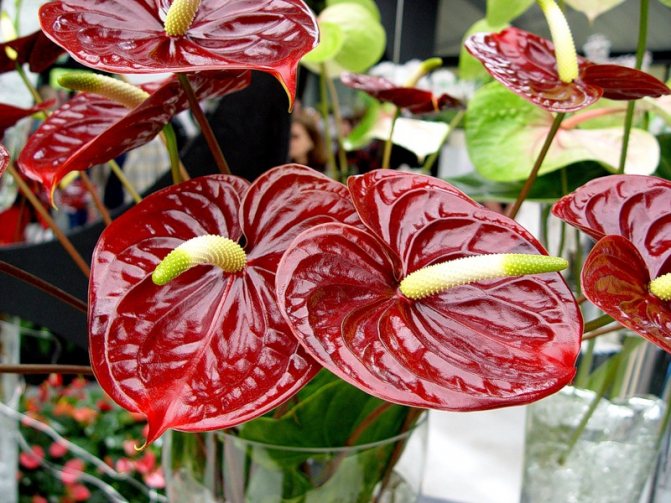

Anthurium flowers smell, the smell is different for different varieties. Most anthurium varieties have large, hard, green leaves. The shape ranges from arrow-shaped to heart-shaped. The leaf is covered with a thin matte membrane. The flower can stretch up to 70 centimeters in height.
What does anthurium look like in the interior?
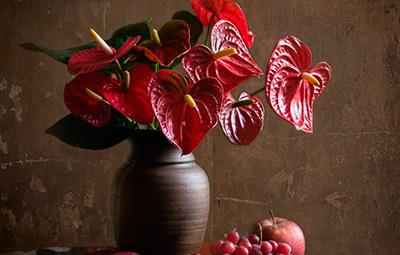

Anthurium flowers are very popular among those who appreciate beauty and are used to enjoying the little things.
Its striking appearance is able to dilute the boring interior of the room and add that touch that was missing.
Since "Man's Happiness" includes more than 800 species, then you can choose its color and appearance, according to the design of the apartment.
It should be borne in mind that the smell of the flower may differ depending on the species. The aroma ranges from the most delicate and pleasant, to sharp and fetid.
Most of all, he is popular with artists and photographers who prefer to arrange a photo session against his background or include him in the composition of a still life.
Anthurium pleases not only the eye, but is also able to purify the energy of the house, converting it from negative to good. With its owners, as a rule, everything is always easy and has a positive result.
Anthurium, home care
Anthurium is a rather capricious flower, it is not easy to grow it at home, certain types of anthurium are intended exclusively for heated greenhouses. It is many times easier to care for hybrid anthuriums, descended from Andre's Anthurium, in fact, they are now found in the trading network in most cases. These are non-capricious plants, resistant to pests and diseases. Their dimensions are quite compact and multiply without any special problems by dividing a mature bush.
Be careful when working with anthurium: it contains substances that irritate the mucous membranes.
Place and light
After purchasing, anthurium can be placed on any radiant windowsill. However, direct sunlight must be avoided. In this regard, if you have an exclusively southern window available, place the anthurium at a short distance from it (thirty to fifty centimeters) or use shading blinds or tulle during the day. If you put your homemade anthurium to bake directly in the sun without shading, then sun lesions (yellow spots) will appear on the leaves, and the flowers will bloom on overly short petioles.


Western as well as eastern window sills are recognized as the best for placing anthurium. Northern light windows are also suitable. But if they are shaded from the street by trees, then the lighting may become unsatisfactory. And this will affect the state of the plant not in the best way. Cuttings will become excessively long, flowers small, flowering scarce or even disappear altogether. That is why on such windows the anthurium flower at home will need to be illuminated additionally, using lamps (fluorescent, gas-discharge, LED).
Temperature
Anthurium adapts remarkably to room temperature. In its natural environment, it grows in the tropics. In the warm season, the best temperature for him will be twenty-twenty-five ° C. In winter, it will be quite 16-18 ° C, but the plant must be protected from warm radiators. Drafts, as well as sudden changes in temperature, can cause the death of a flower.
Soil and fertilizer
Ready-made soil mixtures specified for succulent plants are perfect. The pot for the anthurium should not be too loose, but with good drainage. If you independently organize everything you need, you can mix leafy soil, humus and peat in equal proportions. Then add half a portion of sand and, of course, brick chips, charcoal or expanded clay.
The soil for anthurium should be slightly acidic, and special mineral complexes should be used for feeding. The stage of active growth begins from March to September, at this particular time it is necessary to apply top dressing for decorative flowering plants. During dormancy (October-February), fertilizer can be applied to decorative deciduous houseplants, only halve the usual dosage.
Watering
Anthurium is considered a tropical plant, which is why it needs rich, but infrequent watering. In the summer, it is watered without stagnation of water in the pan every three to four days. If the water stagnates, this can cause the appearance of mold, as well as fungus, which will disrupt the root system.
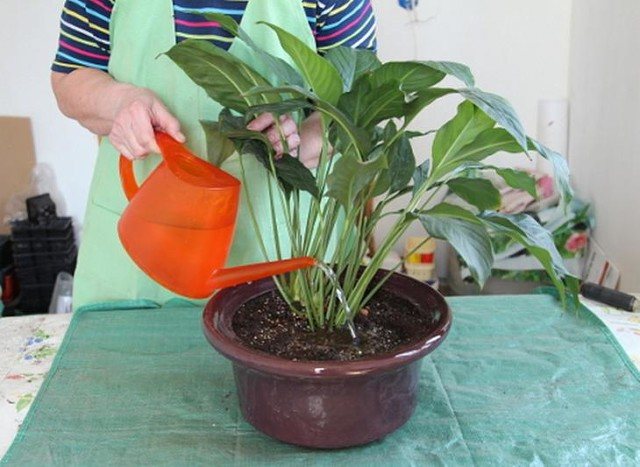

During a period of calm, in other words, in winter, watering is sharply cut. Water only once a week, but do not stop moisturizing with frequent spraying, use a warm shower, as well as air humidifiers. It is recommended to wipe the leaves with a soft, damp sponge to remove dust and additional wetting.
Anthurium transplant
Young specimens are transplanted every two years, and adult plants every three years. A high-quality drainage from expanded clay or other material is laid at the bottom of the pot. A layer of sphagnum moss or coconut fiber is placed on top of the drain.
The next layer already consists of a specially prepared mixture. Anthurium is taken out of the old pot along with an earthen lump. To make the process easier, the earth is moistened. As far as possible, the earthen lump is shaken off the old soil and placed in a new container. The resulting voids between the walls of the pot and the earthy clod are filled with earth.
During planting, the plant is planted deeper so that the root system does not appear on the surface and does not begin to dry out. The aerial roots are covered with moist moss to avoid drying out.
Reproduction
Anthuriums are propagated by apical cuttings with a small number of aerial roots. It is also propagated by division, when lateral shoots develop, and by seeds. Delenki are planted in the spring, at the beginning of growth, during transplantation.
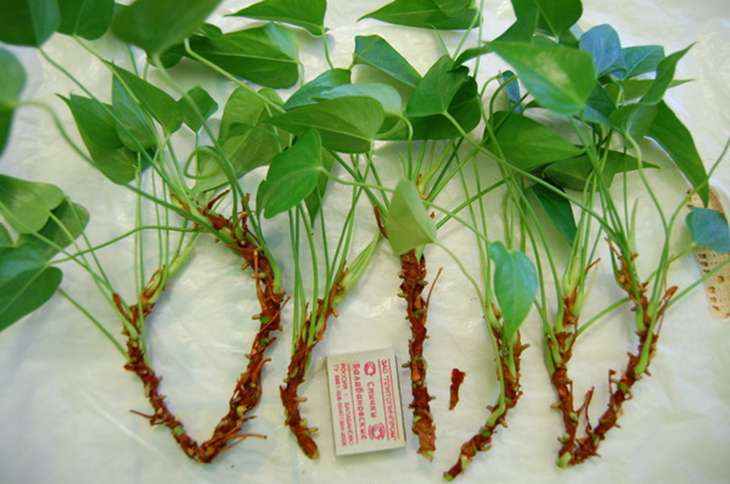

A young plant should be planted in a loose substrate, in a mixture of leafy soil, vermiculite and pine bark. Plants grow faster in loose soil. Watering as it dries. If you got an anthurium stalk without roots, put it rooted in water by adding an activated charcoal tablet to it.
Watering
The mode and intensity of watering depends on the subspecies of the plant. For each species, you need to select your own individual approach and study the features of its origin in its natural habitat.This plant loves moisture, but as mentioned above, overflow can be detrimental to it.
In the summer, Anthurium is watered every 3-4 days.spraying or rubbing the leaves daily. In winter, this effect is reduced to 1 time per week. Use water only if it has settled within three days.
What to do if anthurium is sick
The most likely cause of the disease is improperly based care:
- in case the leaves turn yellow, pay attention to the temperature regime in the room - most likely, the plant is cold;
- the reason for the lack of flowering can be kept in a dark room, poor soil composition, or too large a pot. Change these conditions, and the bush will bloom violently in the near future;
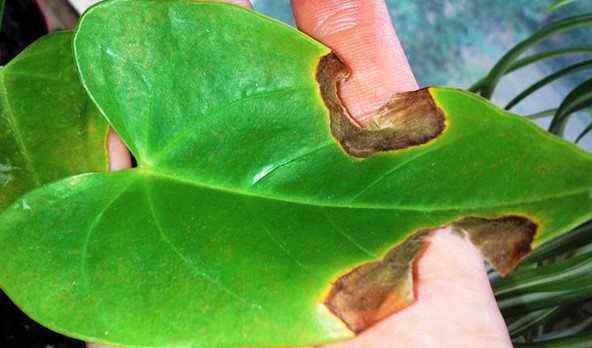

- often brown or yellow spots appear on the leaves or between them. The cause is septoria, which can "jump" to the green part of the plant from other flowers. Also, similar symptoms are caused by infection with downy mildew;
- in case the leaves turn black, examine the water that provides watering. Hard, cold water is not suitable for a plant, it is desirable to filter it.
An unusual bush requires regular monitoring, but if you follow the elementary advice and carefully take care of it, then it will delight you with its unusual exotic flowering.
Answers to popular questions
No one is immune from mistakes. Even an experienced flower grower can unknowingly harm a pet. Consider the answers to the most popular questions asked by the copyright holders of the flower.
Why is it growing poorly?
The reason may be a lack of light or moisture. Feed the plant with mineral supplements. They will help saturate his body with everything necessary for rapid growth.
Why does it fade?
This often happens when your plant is cold. Fusarium disease can be the reason for this sudden behavior. The disease can develop in conditions of excess moisture or infections from dirty hands or pets.
How often does it bloom?
The plant is capable of blooming almost all year round, resting only in the most severe months of winter. With proper care, he begins to dissolve the buds already at the beginning of spring. In a loose state, Anthurium can stand, pleasing the eyes of the owners, for several months.
Also, its flowers retain their original appearance for a long time when cut. As part of a bouquet, it can stand up to 4 weeks.
Reasons for the lack of flowering
Starting a blooming plant at home, every gardener wants to see a bright and such a long-awaited flower. But it also happens that the anthurium forms, builds up a green crown, does not turn yellow, and also does not rot, but there are still no flowers and no. The reasons for the lack of flowering of anthurium can be:
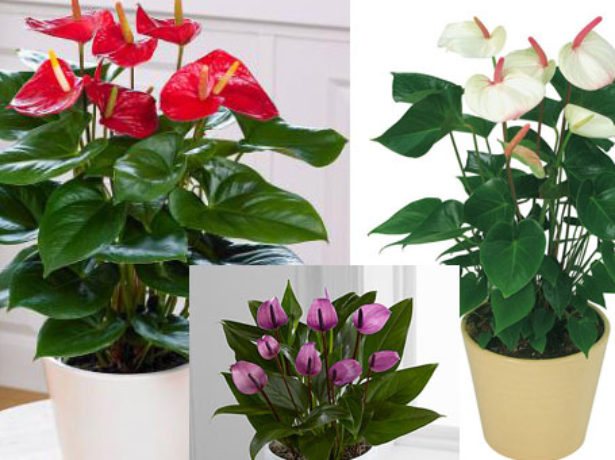

- Temperature violations. Placing the pot close to the window in winter, as well as installing it next to heating radiators, leads to disruption of the flower buds.
- Exposure of plants to direct sunlight. Hyperthermia of leaves and burns inhibit internal vegetative currents, letting all the forces of the plant to regenerate.
- Irrigation and humidification system disturbances. Make sure that the soil does not become dry or waterlogged. Spray the anthurium often in order to create the right level of moisture near the flower.
Anthurium care at home is not an easy problem. Growing anthurium at home will require knowledge and experience. But a well-groomed plant will reward the grower with a bright and inimitable flowering, which will be remembered by everyone who sees it.
Possible diseases and pests
Diseases in this plant are relatively rare. Some problems usually occur with beginners if they make mistakes when caring for the anthurium. If the leaves have brown spots or dots, they may have been sunburned. Also, this phenomenon is a consequence of a long drop in air temperature in the apartment.
If the spots turn yellow, spread through the leaves, provoking them to fall off, you need to understand why this is happening. In most cases, this indicates a fungal infection. In this case, diseases arise - septoria and anthracnose. Insects can be carriers of the fungus. It is also often found in soil and water used for irrigation.
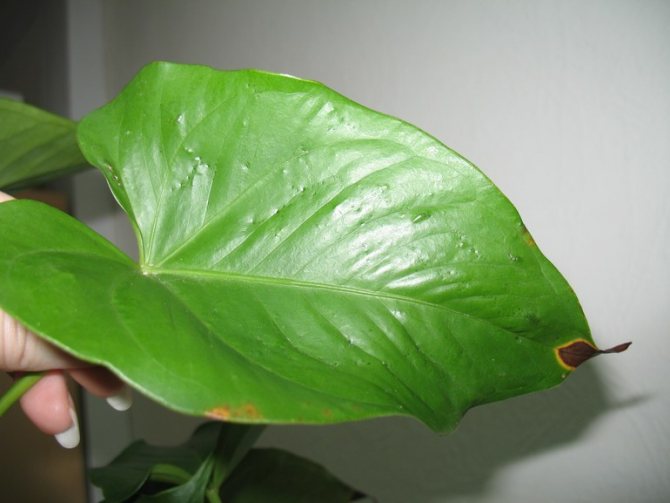

Before starting treatment, the infected flower should be isolated. After that, remove the leaves on which there is a defect, and change the soil. The pot and the root system are treated with a weak solution of potassium permanganate. To do this, immerse them in the mixture for 10 minutes. A transplant is carried out, after which the treatment is carried out with fungicidal preparations, for example, Fundazol.
If there is significant damage on the surface of the plant, you will have to destroy it completely, otherwise infection of all indoor flowers in the apartment cannot be avoided. It also happens that the spots have an unclear origin. This can sometimes signal that drops of moisture have entered the plant during watering. Drying of the tips of the leaves and their darkening indicate an increased content of calcium in the substrate. In this case, you will have to resort to replacing the substrate.
If the roots and stem begin to rot, it means that the grower is watering the plant too abundantly. Reduce the amount of water used. When new flower stalks do not form, it is important to pay attention to the size of the pot. If it is too spacious, the flower should be transplanted. Another indication of improper care is the "tears" on the leaves.
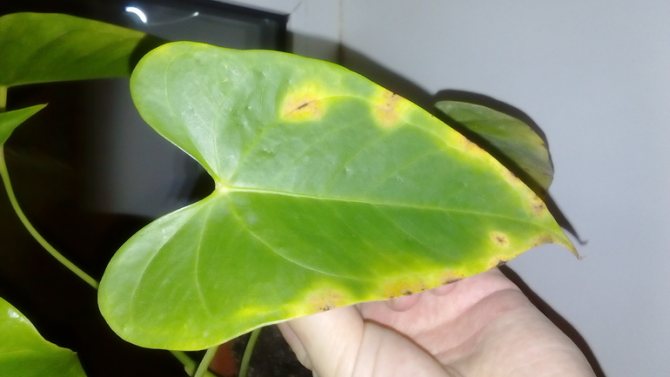

Among the pests, it should be noted:
- shield;
- spider mite;
- aphids.
To prevent their spread, the stems and leaves must be wiped with a cloth soaked in warm water. If the pests nevertheless attacked the culture, it is necessary to treat it with a mixture of laundry soap and water, or with an insecticidal preparation. The use of Karbofos and Actellic products will be optimal.
Anthurium, flower "male happiness": vegetative reproduction
This procedure can be carried out as follows:
- Cuttings. It is necessary to cut off the stem of the plant 20 cm long. It is best to have leaves on it. The stalk is placed in a pot of vermiculite, deepening 5 cm into the substrate. After a month, you can already see the roots. Next, the plant is transplanted into ordinary soil.
- The flower "male happiness" also reproduces well by the method of dividing the rhizome. This can only be done if the plant has already grown well (usually 4-5 years after planting). The rhizome must be divided so that at least one renewal bud remains on each fragment.
- Sheet. This method is rather complicated. It does not always give a positive result. How does the flower "male happiness" multiply in this way? You can try to cut off a leaf blade, twist it with a tube and fasten it with a soft rubber band. Such a structure should be placed in a wet mixture of moss and peat, and covered with a jar on top. The ground should completely cover the leaf. A sprout should appear in 3 weeks.
The value of a plant in Feng Shui
Anthurium has positive properties that charge the human biofield only with good emotions. The flower "male happiness", the care and reproduction of which we will consider below, has a beneficial effect on the thoughts of the inhabitants of the house, making them clear and conscious. Thanks to this green pet, the home will be filled with harmony. The flower can cleanse the aura in the room, destroy the negative. If the person who cares for him has a bad temper, the anthurium will look sickly.
What kind of soil is right?
The soil can be prepared on your own or you can buy specialized soil in any flower shop, which necessarily includes pieces of pine bark 2 - 3 cm in size and agroperlite of a fine fraction.
The main requirement is that the earth must be with a slightly acidic reaction.Also have a loose consistency and consist of coarse fibers in order to optimally pass moisture and air.
Soil preparation advice:
- Take each component in one part and mix - peat, coniferous soil, coarse sand and leafy soil. Remove large items.
- The prepared mixture must be disinfected. To do this, put it in the freezer of the refrigerator for a day.
Bloom
With proper care of the "male happiness" flower, the plant not only becomes more beautiful, but also gives positive emotions. Its flowering period is February – November. It stops only in the most severe cold weather. Flowers stay on the stems for a long time. If you cut them off, they will stand in a vase of water for about 3 weeks. It is said that at the moment of flowering, the plant has forces that affect the environment. Most often, during this period of time, the tenants are doing better, their mood improves. But for this it is necessary to carry out high-quality care of the flower "male happiness". Reproduction of this plant is not difficult. With the right approach, you can make it grow in every room.
Popular and rare varieties
Most often on sale you can find anthurium or male happiness in red and white. These are the most adapted varieties and can tolerate maintenance deficiencies. However, there are other bright colors that are more demanding to maintain, but they are less common.
Scherzer's Anthurium
A distinctive feature of the variety is a spirally twisted ear. The color can be different - red, orange, spotted.
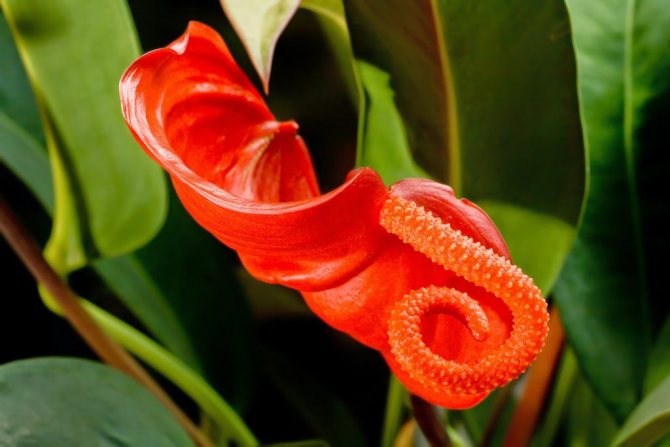

Dakota
Large variety, can reach a height of one meter. The color of the cover of the peduncle is maroon with long ears.
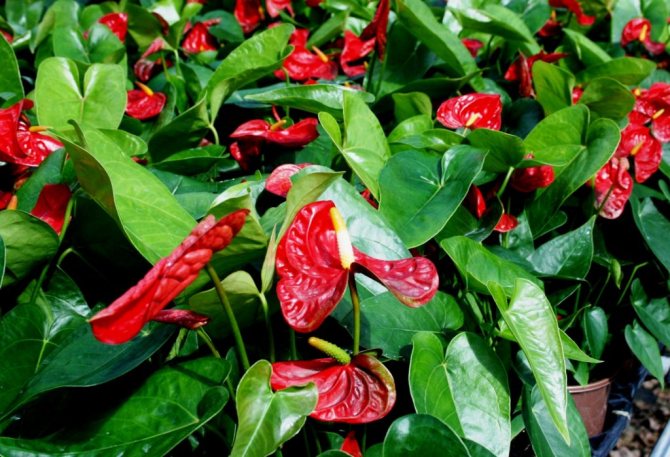

Cavalli
Cavalli and Fiorino varieties are similar in color of the bedspread - pink or purple, and the same color of the cobs.
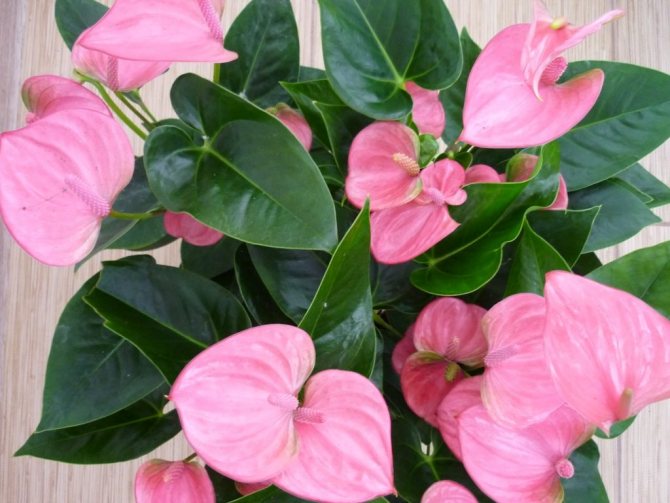

Crystal
Prized for its bright leaves, it is called an ornamental deciduous plant. The plates are large, with silvery veins that stand out against the background of greenery. The flower does not attract attention, since it does not have a beautiful veil - only a long stamen.
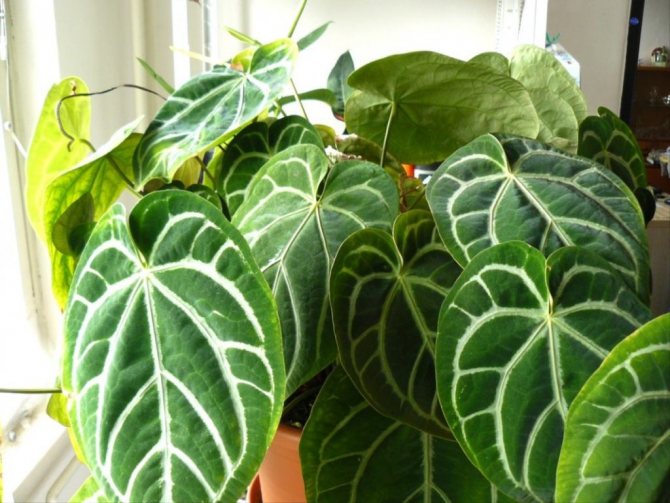

Veitch
An epiphytic plant with huge sinewy leaves reaching 2 meters. The flowers have a light green nondescript veil, so they do not attract attention.
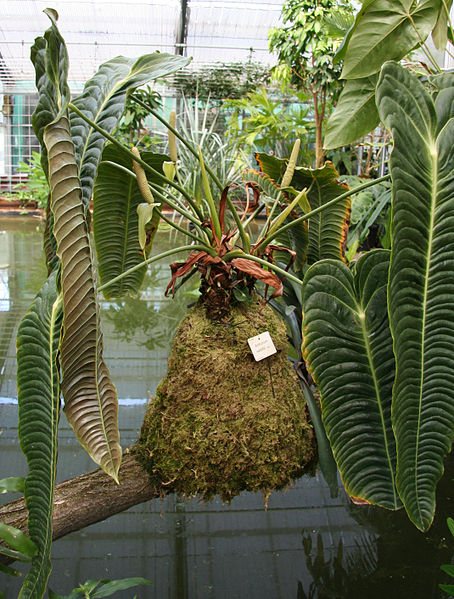

Anthurium majestic
The leaves are large, heart-shaped, blue-green in color with prominent veins. Flowering is almost imperceptible.
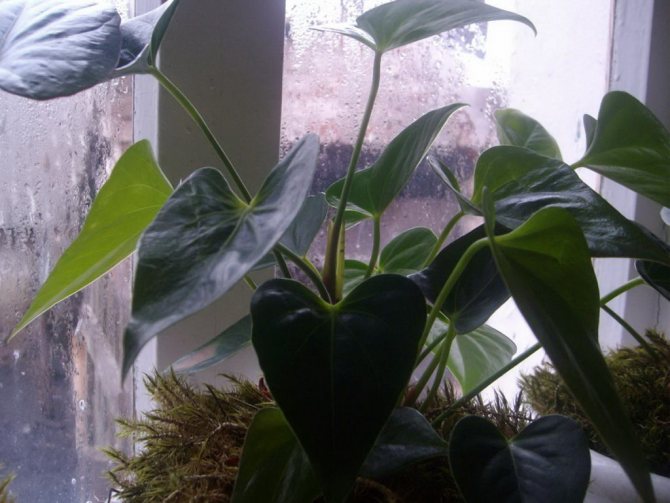

Baker
Anthurium Baker is distinguished by long leaves, but the peduncle has practically no cover. After pollination, berries are formed on it.
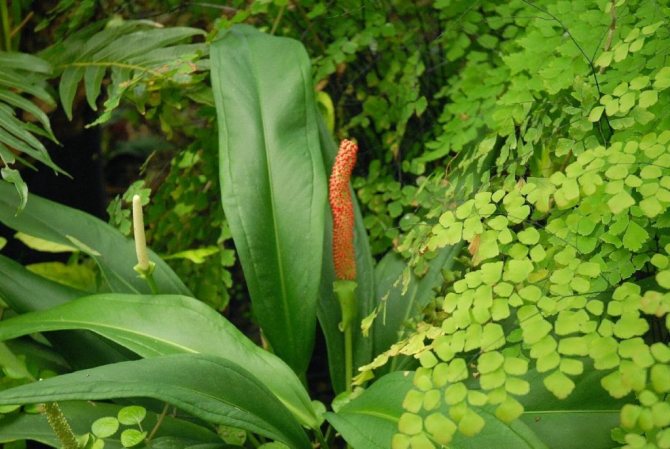

Black Prince
The most unusual variety, which includes three subspecies. One of them is the Black Prince. The bedspread becomes dark burgundy over time, almost black. The ear is usually green or yellow in color.
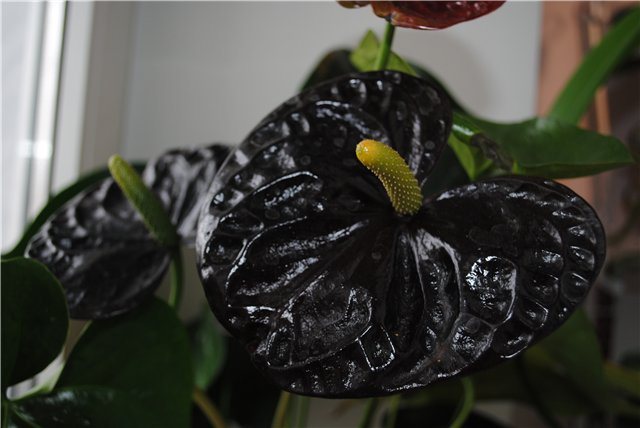

Princess Alexia
The bract is yellow in color, almost triangular in shape, which is different from all the varieties described above. A very capricious variety to care for, therefore, not suitable for beginners.
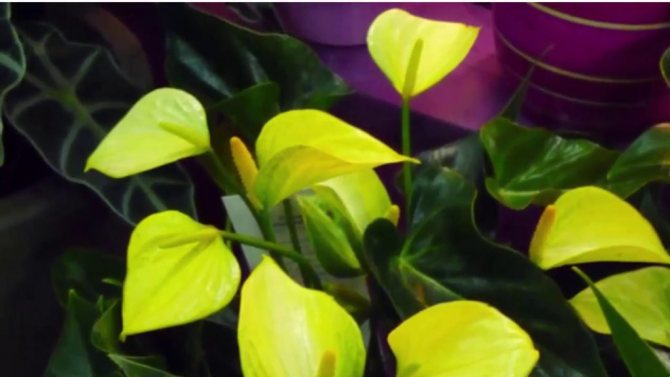

Multi-cut
The leaves of this species are not at all like most representatives of anthuriums. They look more like miniature palms.
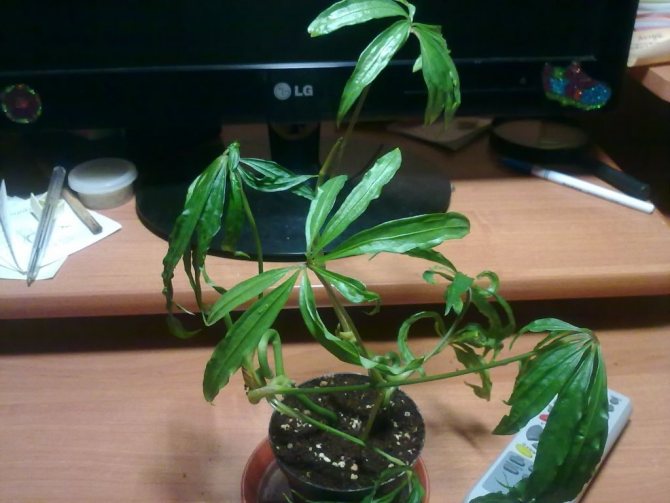

Views
Anthuriums are the most numerous representatives of their family. According to some sources, the number of species of this plant is more than 500. But as it turned out, this is already outdated data, modern scientists have expanded the list to 900 names. The most popular in indoor floriculture are several species that are valued for their decorative qualities.
| Types and varieties | Description |
| Anthurium Andre | Herbaceous evergreen perennial. Leaves similar to an elongated heart are located on a long petiole and have a rather large size - up to 30 cm long, 10 - 12 cm wide. The surface of the leaf plate is dense, semi-glossy, green in color. Broad-heart cover, slightly wrinkled, with pronounced veins, glossy shining. It can be different in color - salmon, pink, red, less often white.Inflorescence is a yellow ear up to 10 cm long, erect or sometimes drooping. This species is very decorative and is very popular among flower growers. |
| Anthurium Andre Champion | A varietal plant of medium size and surprisingly beautiful dark green foliage. The flowers are small, but the Champion is famous for their abundance. The color of the bedspread, depending on the variety, can be pink or white with a slight yellowish tinge. |
| Scherzer's Anthurium | Epiphyte, sometimes short-stemmed terrestrial plant. The petiole on which the leaf is attached has a length of 4 to 20 cm. Elliptical or lanceolate leaves with a pointed apex have a dense structure. The top is glossy, the bottom is matte. The color is dark green. A distinctive feature is the flower. The bedspread is colored red-orange, which does not lose its brightness for a long time. Glossy surface, medium density structure. The inflorescence is a cob twisted in a spiral, colored yellow or orange. One of the most popular potted varieties. |
| Crystal anthurium | Leads an epiphytic lifestyle. The leaves are large, almost 40 cm long. They have an elongated oval shape, with a pointed apex. Deeply lobed at the base. They are appreciated for their extraordinary color. Against the dark green background, the areas of the veins, painted in a silvery-white color, stand out in contrast. Small bedspread - up to 9 cm, semi-leathery, green. Inflorescence is a yellow ear tapering towards the top, 12 cm long. |
| Anthurium Baker | Epiphyte with stems 10 cm long. Leaves are narrow, elliptical-lanceolate, 20 to 55 cm long. The leaf plate is dull, dark green above, lighter on the underside. The flowers are inconspicuous, located below the level of the foliage. The cover is small, 2.5 to 5 cm long. The surface is leathery, painted in pale yellow-green tones. There is a purple edging along the edge. The inflorescence is an 11-centimeter ear of white-cream color. |
| Anthurium mix | This is a group of hybrids derived from common species - André and Scherzer. Perfectly adapted to home conditions, they do not require special attention. As a rule, these plants have a compact size and a variety of cover colors. |
Species and varietal diversity of anthurium - photo gallery
Anthurium flowers Andre conquer with beauty
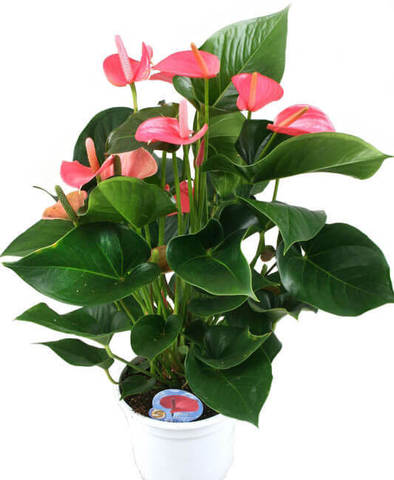

Anthurium Andre Champion has a slightly smaller flower size, but more in number
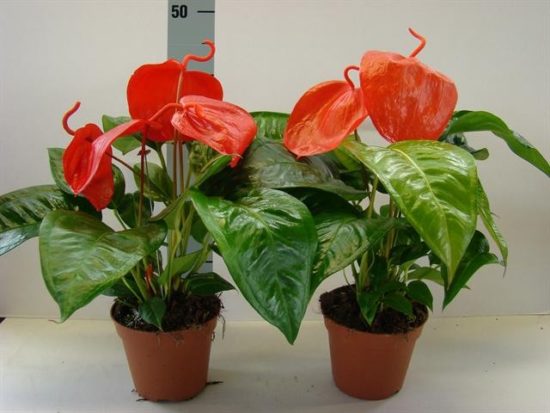

Scherzer's anthurium stands out with a spiral-shaped inflorescence
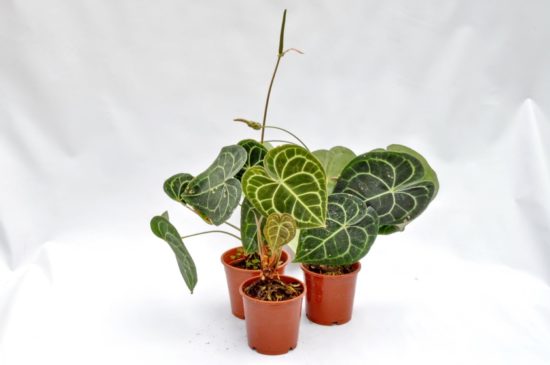

Crystal Anthurium has luxurious foliage
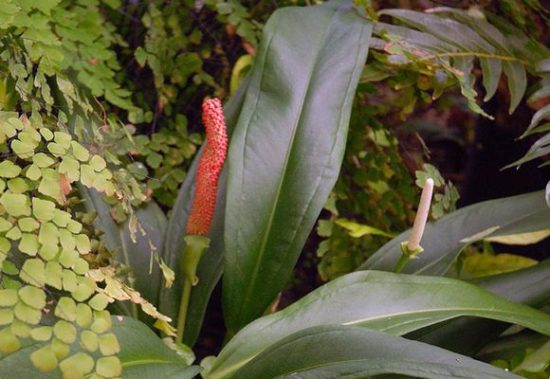

Anthurium Baker outwardly does not look at all like other species
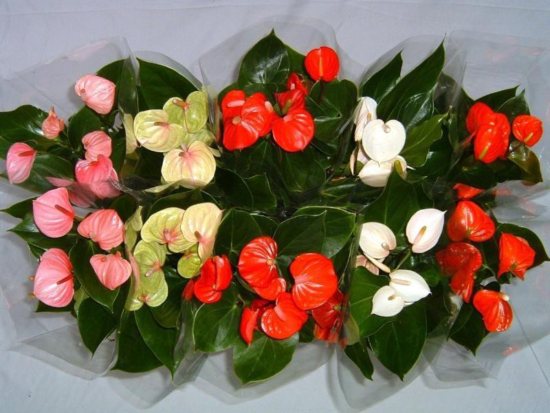

Anthurium mix - color variety of hybrid plants
What else can you grow with them in the same room?
It is not recommended to grow other plants in the same container with anthurium or spathiphyllum. On the same windowsill with anthurium, it will be good for light-loving and heat-loving plants, for example:
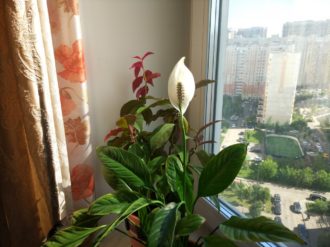

- aphelandra;
- coleus;
- sankhetsia;
- dieffenbachia and others.
In contrast, plants that prefer shade and moisture will make good neighbors for spathiphyllums, for example:
- dracaena;
- violet;
- fat woman;
- ficus;
- ferns and more.
Attention! It should be remembered that the sap of both plants is poisonous, therefore contact with the skin and other plants should be avoided.
Humidity for male anthurium flower
Decorative deciduous species are more in need of high humidity (60-80%) than flowering (50-60%).


Ideally, you need to adjust the level of humidity depending on the temperature in the room and the state of the flower. Excessively high humidity in winter at temperatures of 16-18 ° C or in summer heat with poor ventilation contributes to the development of fungal diseases. At the same time, low humidity makes "male happiness" more vulnerable to pest infestation.
In practice, to increase the humidity of the air, some growers spray the plant every day, others wipe the leaves, still others use a humidifier, and the fourth are all in a complex.
Fresh articles about garden and vegetable garden
Saintpaulia photo with the names of the variety
Salvia perennial: tips for growing and care, photos
The blind man in the country: how to get rid of?
Why do you need to transplant "male happiness" into another land?
It is necessary to transplant anthurium so that the plant receives all the important trace elements and nutrients. When a flower grows out of a pot, there is no free space left for growth inside. Roots fill the entire space. The flower can no longer develop well and fully eat.
The land needs to be changed from time to time. Buy ready-made soil, which should contain crushed bark, expanded clay, sphagnum moss, charcoal. Universal potting mixes will not work.
In addition to a transplant during a favorable period of rest, there are urgent situations. The reasons can be different:
- unpleasant smell of the earth;
- decay of the root system;
- you need to transplant a purchased flower from a peat mixture;
- plant disease;
- replacing a damaged pot.
If help is not provided in time, the flower may die.
The history of the origin of anthurium
Without a doubt, one of the most representative and attractive indoor plants is the handsome anthurium. For experienced florists, it becomes the pride of a home collection. And for beginners, it evokes awe and awe. But this does not prevent anthurium from being among the best-selling plants, although the price of a tropical exotic is far from low.
Anthurium is native to Central and South America. The distribution area is limited to Mexico, Paraguay and Argentina. It grows both in humid tropical and subtropical regions and in mountainous areas. The flower can be found in lowland areas and at an altitude of 3400 m above sea level.
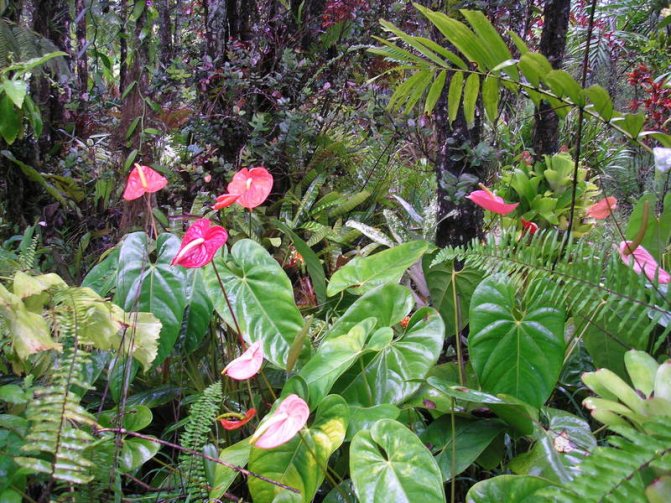

Probably, the heart of a person who saw such beauty in nature sank with delight.
For the first time, an outlandish flower was described in 1829. Due to its capricious nature, the plant did not receive wide distribution, it was grown exclusively in greenhouses, observing all the rules of care. But with the advent of hybrids that adapted to new conditions, anthurium began to conquer new spaces with wide strides.
Anthurium has several common names - male happiness, flamingo flower, red tongue. The literal translation from Latin "tail" and "flower" characterizes the appearance of the plant. And the legend about a girl who preferred death in a fire to marry an unloved one is also connected with the extraordinary flower. At the place of the death of the proud beauty, scarlet flowers grew. The story is very sad, but thanks to it, the anthurium has become a symbol of faithful love, and the flower itself has become a talisman for newlyweds.
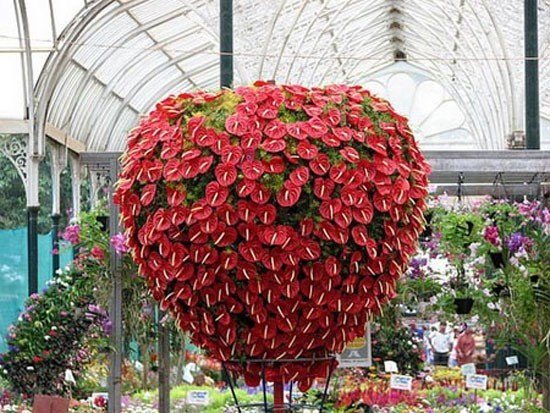

Anthurium is a wonderful gift for newlyweds
Characteristics and description of the flower
Anthurium belongs to the genus of evergreen perennial plants of the Aroid family. Presented in the form of herbaceous or climbing forms, tree-like specimens are very rare. Most of the species are epiphytes and semi-epiphytes. But there are also lithophytes, that is, plants adapted to life among stones.
Plant height from 40 to 80 cm. Stems are thickened, with shortened internodes. The leaf plate, depending on the type, can have a different shape - round, lanceolate, arrow-shaped, heart-shaped, spatulate, with a blunt apex or pointed. In addition, the leaves can be whole or difficult to cut, differing in texture - it is mostly dense, leathery, but there are also fragile leaves that resemble thin paper. The surface of the plate is almost always glossy or semi-glossy. Species with matte velvety leaves are rare.
Among the lush, rich greenery, flowers stand out in bright spots. The structure of the flower bedspread is leathery, hard. The color scheme is different. In nature, white or green are often found. But the varieties grown for indoor breeding are striking in their variegation - pink, orange, bright red.Hybrid forms even surprise with their multicolored color. The inflorescence is an ear. In shape, it can be club-shaped, spiral-shaped, spherical or cone-shaped.
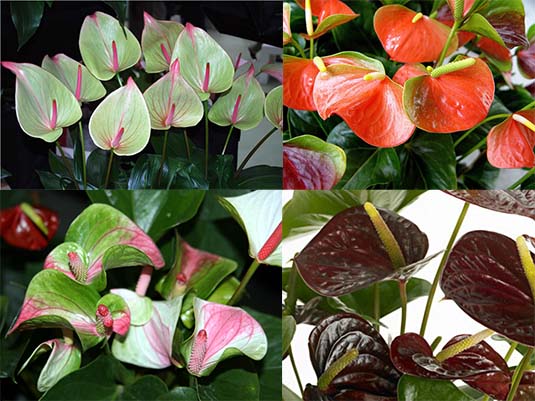

Anthurium boasts a wide variety of flower bedspreads colors
Air roots. Their ends, directed upward, are covered with a spongy, hygroscopic dead tissue - velamen, capable of maintaining the viability of a plant in conditions of alternating high humidity and dry periods.
The best place to plant
In order for the energy of the plant to be only positive, it must be correctly positioned. Here are some rules:
- It is better to place the flower in the eastern part of the apartment.
- The bedroom is a great place for life and anthurium bloom.
- Do not place near electrical appliances.
- Do not place in places where there is direct sunlight, otherwise the leaves will get burned. However, the windowsill where the anthurium lives should be very light.


What to do if the buds of a flower have fallen off?
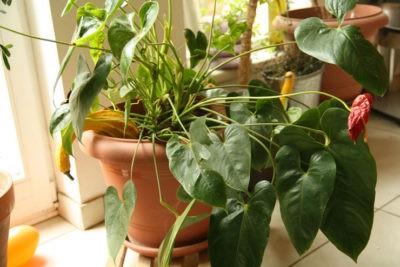

Sometimes flower growers have a sad situation when the buds fall sharply. Violation of the conditions and rules of home care for a flowering plant explains why this happens.
If such a situation arises, it is necessary:
- Analyze the conditions in which the flower grows.
- Check the soil moisture in the pot, whether the air temperature in the room has changed, whether the flower suffers from a lack or excess of light, inspect the leaves and stems for diseases and pests.
- If violations of the rules of care have been identified, correct them. If diseases or pests are detected, treat the flower with special means.
Note! One of the most common causes is irrigation problems. Considering that the plant needs more moisture during flowering, they simply start to flood it. As a result, flowering stops. In such a situation, adjusting the irrigation regime will help.
Plant pruning
Formative pruning for anthurium is not used, since the plant is independently capable of creating a lush deciduous rosette. In cases where an adult bush stops throwing out inflorescences or its decorative appearance is lost, pruning can be used. Thus, the flower is rejuvenated.
In the process of trimming, the apical part with a couple of roots is removed. At the same time, several internodes must be left on the trunk for bushiness. The removed parts can be rooted in a lightweight substrate.
Shrub soil
Anthurium develops better in a loose soil mixture that is not tamped and has a weak acidity. You can mix the soil for planting yourself:
- Deciduous soil - 1 part;
- Sod land - 2 parts;
- Coarse sand - 1 part;
- Peat layer - 1 part.
- You can add some marsh moss.
Popular: Indoor ornamental shrub azistasia with long flowering
This soil composition is capable of retaining moisture. In addition, it is as close as possible in the soil, where anthurium grows in nature. But you can buy a ready-made substrate for aroid plants in the store.
How is feeding
In early spring and in summer, it is customary to apply liquid fertilizing solutions under the plant. This procedure is done twice a month. For top dressing, both organic matter and mineral complexes are used. Some growers additionally use universal options that contain both types of dressings at once.
Organic fertilizers are rotted humus, thoroughly fermented cow cakes or bird droppings. Mineral complexes include the drug "Azalea", "Kemira Lux" and others. When breeding such dressings, it is recommended to reduce the dosage by half of what is prescribed on the package. They bring it in after watering the plant.
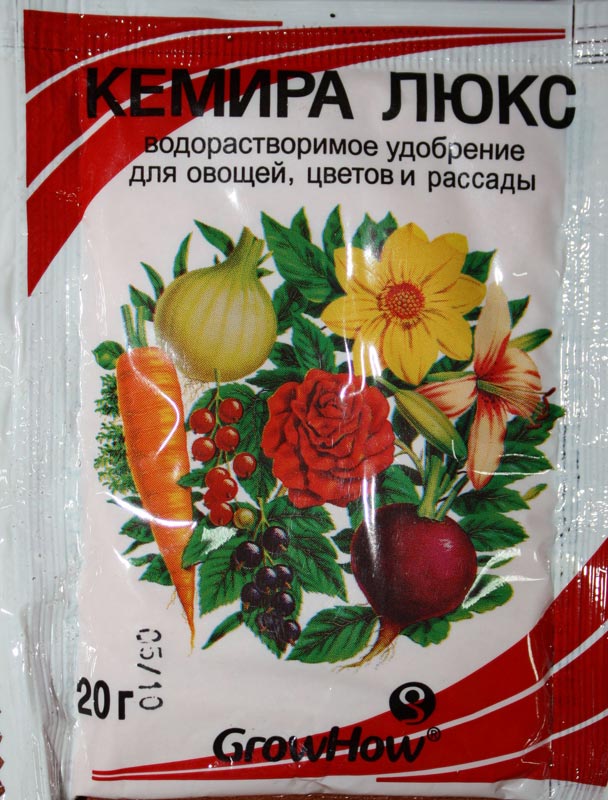

Popular types and varieties of anthurium for growing at home
The tropical plant has many varieties.Instances differ not only in the color of the bracts, but also in the height of the bush, the shape and shade of the leaves. It is no coincidence that anthurium has several popular names: "tail flower", "flamingo", "male flower", "fiery tongue". Different varieties have their own requirements for keeping conditions: shade-tolerant and light-loving, decorative-flowering and decorative-deciduous.
Popular types of anthurium with spectacular bracts:
- Anthurium Andreanum. The ear is 6 cm long, the bush is not high (about 20 cm and the same width), the bract is like a heart, the foliage is bright green.
- Anthurium scherzerianum. The length of the coiled ear is 8 cm, the bract is spherical, rich orange, the length of the pedicels is 40-50 cm.
The main species became the ancestors of numerous hybrids, with original shades of bracts and leaves. Plants with a scarlet, pale pink, coral veil are popular. Varieties with white, crimson, reddish-green, purple, salmon, lilac, yellowish blankets look spectacular. Some varieties (Anthurium x rothschildianum) have blotches of a different shade on the bedspread.
Popular varieties:
- Robino.
- Vitara.
- Arizona.
- Mystique.
- Sensa.
- Avento.
- Hanna.
- Smaragd.
- Lacetti.
- Fiorino.
- Artus.
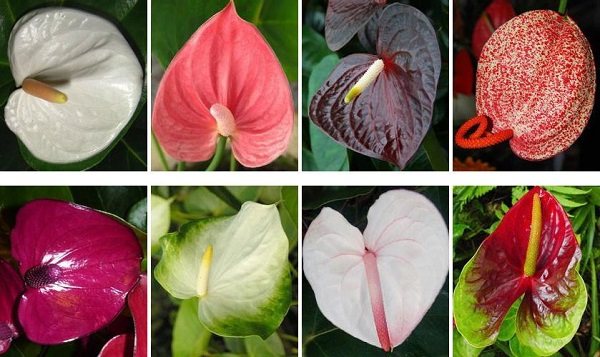

Decorative deciduous varieties:
- Majestic.
- Crystal.
- Climbing.
- Dissected.
- Baker.
- Wendlinger.
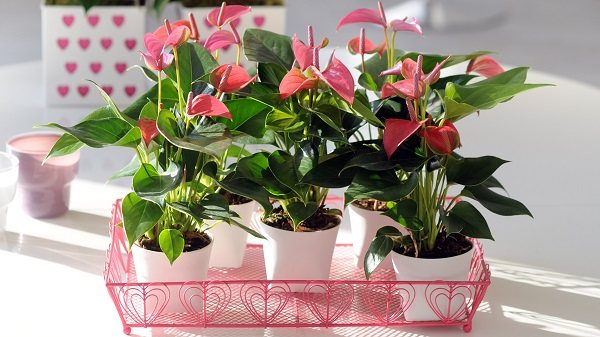

Transfer and boarding tips
Before planting or transplanting anthurium, prepare everything you need so that the plant does not experience discomfort after the procedure.
Capacity requirements
Anthurium does not require a large pot. The volume of the container should slightly exceed the size of the plant's root system. In a container that is too large, there is a danger of waterlogging the soil, which means that the roots will suffer. The material from which the pot is made matters. Many growers prefer to grow in plastic pots. But based on my own experience, I can note that anthurium feels very good in ceramics.
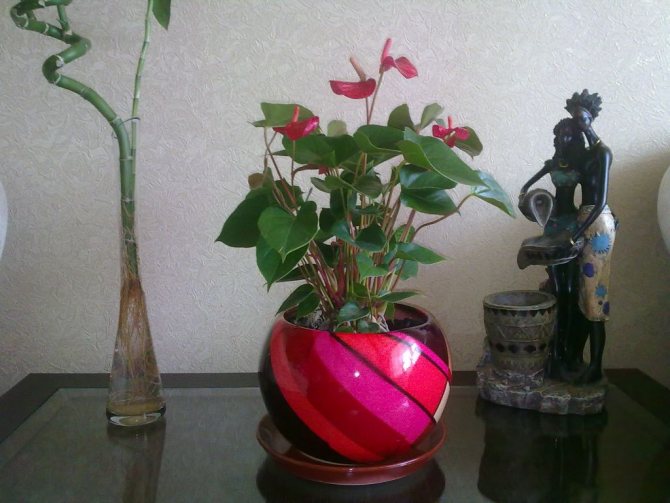

Select a pot for anthurium according to the size of the root system
The pot for transplanting must necessarily have drainage holes for draining the water.
The soil
This is perhaps the main requirement in the process of transplanting or planting. Anthurium will not grow in randomly acquired soil. The soil should be close to natural, which means it should have sufficient looseness, moisture and air capacity. The reaction should be slightly acidic - pH 5.0 - 6.0. It is easy to prepare such a substrate on your own by purchasing the necessary ingredients in advance. There can be several compositions, the main thing is to mix all the components well.
- 2 parts of moss and peat, 1 part of sod land;
- equal amounts of peat, deciduous soil, coarse sand, coniferous bark and charcoal;
- 2 parts of small pieces of pumice (1 - 3 cm), 2 parts of pine bark, 1 part of coarse fibrous peat, 1 part of well-decomposed horse manure.
The coarse soil will hold the plant well in place and will not quickly disintegrate and compact. Thanks to this, the soil breathes perfectly and allows moisture to pass through.
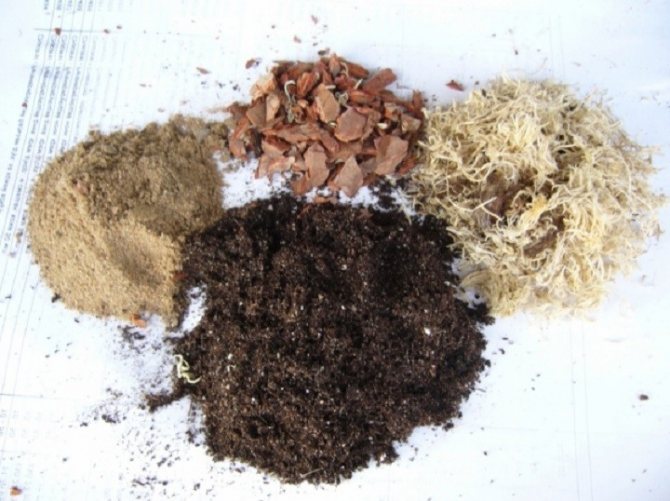

Soil mixture for anthurium, composed of large particles, perfectly holds the plant in the pot and does not cake
When to transplant
For a young plant, the transplant is carried out annually, each time slightly increasing the volume of the container. Adult anthuriums no longer need to be disturbed so often. For them, the planting process is carried out once every 3-4 years.
Usually, transplanting is done in the spring, at the moment when the plant comes out of the dormant period and begins to grow rapidly. But there are times when it is urgent to change the old container for a new one. This can happen if the acquired anthurium is in waterlogged soil or the root system has become too crowded in the old space and the roots have already begun to grow through the drainage holes. Also, an urgent transplant is required if an illness is detected.
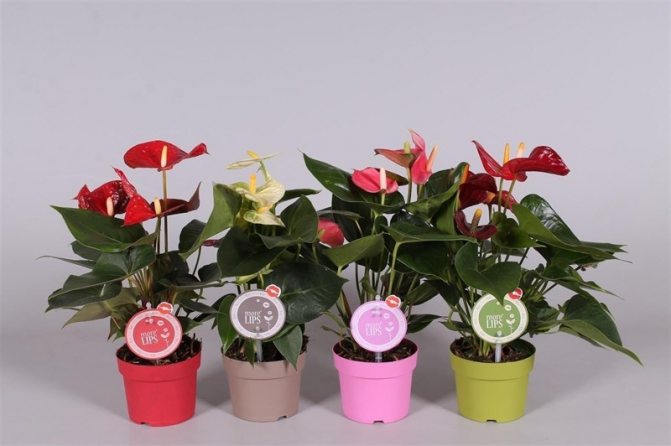

Anthurium purchased in the store needs to be transplanted
Planting process
Water the anthurium abundantly 2 to 3 days before transplanting. If the plant has not been watered for a long time, its roots will be very fragile and may break during transplantation.
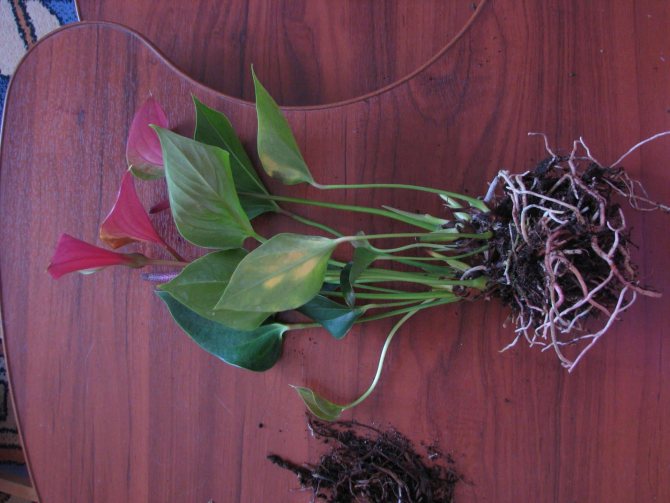

Anthurium has very fragile roots, so 2 - 3 days before planting, the plant needs to be watered
- Take a new container with holes in the bottom. Be sure to lay a drainage layer. Pour some prepared substrate on top.
- Remove the plant from the old pot, holding the base of the bush with one hand and grasping the bottom of the container with the other. Try to be careful not to damage the roots.
- If possible, clean the old soil from the roots. If the leaves show signs of disease, pay attention to the root system. Examine it, remove the rotten areas and cover the wounds with activated charcoal.
- Place the anthurium in the center of the pot and add new potting soil around the edges. In this case, you can lightly tap the pot on the table surface to help the soil more evenly fill the space in the roots.
- When transplanting the anthurium, slightly deepen it so that the new roots are hidden in the soil. But do not overdo it, otherwise the plant may rot.
- Water the anthurium sparingly if transplanted into dry soil, but watered wet only after the soil mixture has dried.
- Place the transplanted flower out of direct sunlight.
- For better engraftment, you can spray the leaves with a solution of Epin or Zircon. But before that, be sure to read the instructions.
Anthurium transplant secrets - video
Anthurium in the house: signs and superstitions
Common Opinions About The Influence Of Tropical Color:
- restores masculine strength;
- helps to get rid of tobacco smoking and cravings for alcohol;
- attracts money;
- gives self-confidence;
- attracts love and betrothed to the house of an unmarried woman;
- activates vitality;
- emphasizes the importance of a man as a protector of the family;
- together with spathiphyllum (flower "female happiness"), it preserves peace and mutual understanding of the spouses.
Before buying an anthurium, you need to clarify what conditions are needed for a tropical flower at home. Anyone who does not tolerate high humidity should choose another, less capricious plant, for example Pelargonium, Decembrist, lemon tree, Eucharis.
How to grow Anthurium? How to water the plant? How to transplant, rejuvenate and propagate a flower? Answers to these and other questions in the following video:
Watering anthurium
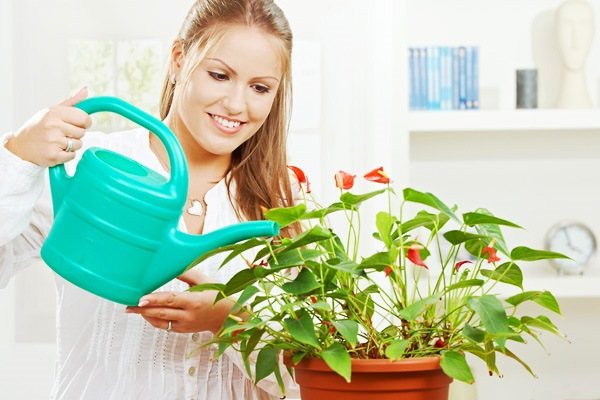

Since anthurium is a tropical plant, it must be watered abundantly, but not often, with warm, settled water. It is advisable to add a few drops of citric or acetic acid to the water to soften the hardness of the water and acidify the soil. If your water is too hard, the tips of the leaves will turn brown. The plant must be watered when the topsoil is well dry from the previous watering. Usually, this happens on the third or fourth day in the summer or a week later in the winter.
Keep in mind - the lower the ambient temperature, the less often your flower needs to be watered.
Be sure to drain excess water from the pan, as stagnant water can cause rotting of the roots of anthurium or provoke the occurrence of fungal diseases.
One-time watering of anthurium at the end of winter is very warm, up to 50 gr. Celsius with water, will provoke him to a lush bloom!
Folk omens
Owners of male happiness will be interested to know that:
- Tears appear on the tips of the leaves before the rain (guttation);
- if the anthurium bloomed, then the family received a blessing and a white streak has come;
- perennial, bright red, flowering bush bestows good luck and wealth;
- strengthens the family, and the lonely find their love;
- all properties are activated, only in the plant presented to you, you cannot buy it personally for yourself.
According to Feng Shui, male happiness absorbs bad energy and saturates the house with a blissful aura, clear consciousness. I can imagine what a flower looks like if everything is very, very bad in the house. It is unlikely that he will survive from continuous and hard work.
Signs
There are many beliefs associated with this amazing plant:
- If the family is on the verge of divorce, then you need to purchase an anthurium. The flower will help freshen up the relationship.
- Financial difficulties can be corrected with the help of this plant. It will attract money into the house, but only on the condition that caring for it will be complete.
- Anthurium will help a girl to attract a young man to her house, but a man must necessarily sell her a flower.
- Anthurium absorbs negative energy and fills the apartment with only positive emotions.
- Flowers that have been donated have strong properties.
Photo
Next, you will see how anthurium and spathiphyllum look together.

